Posts Tagged ‘Blue Mountains’
Thursday, July 11th, 2013
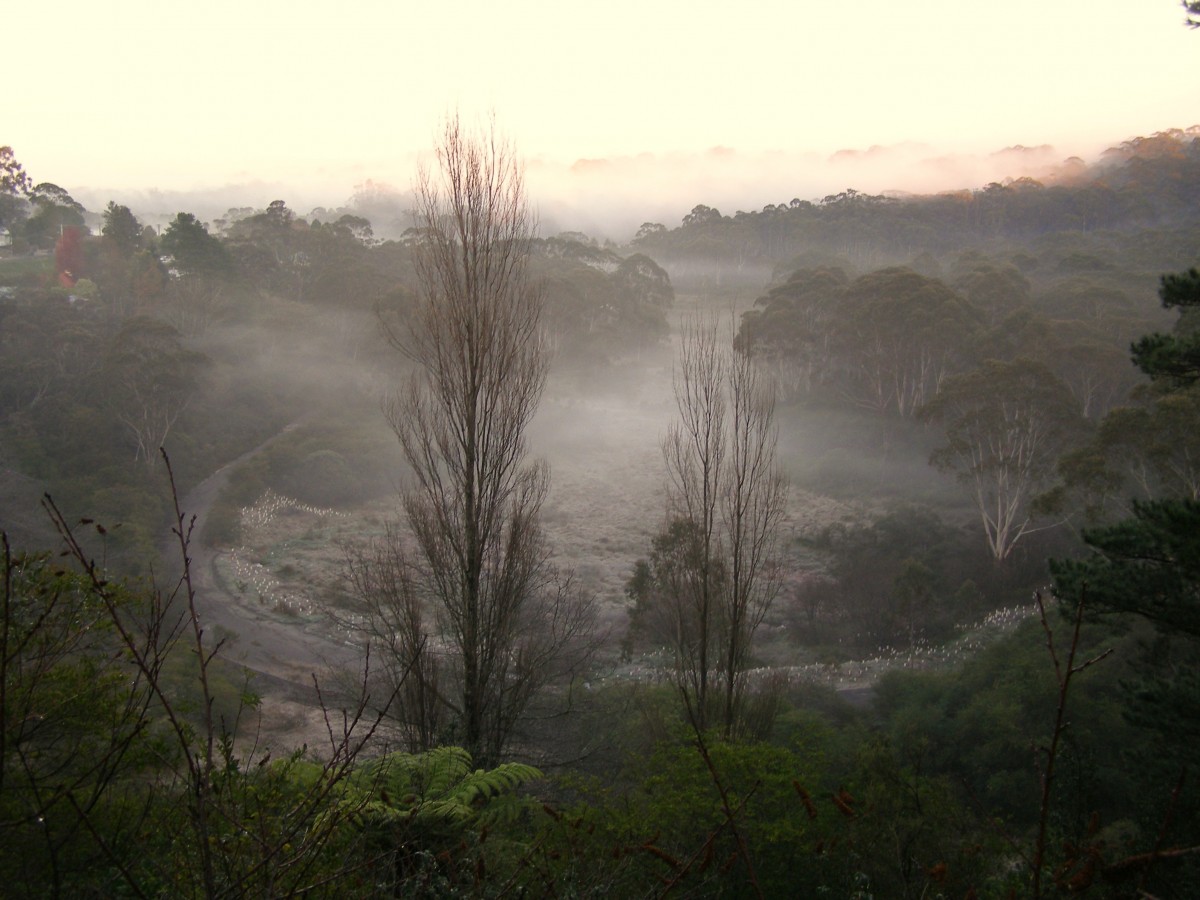 Frosty Morning in the Gully
[Photo by Editor, 20130711, Photo © under ^Creative Commons]
Click image to enlarge Frosty Morning in the Gully
[Photo by Editor, 20130711, Photo © under ^Creative Commons]
Click image to enlarge
.
Calling Me Home
.
<< I can feel the souls of my ancestors calling me back home
To all the familiar places and tracks I once did roam
I can see my Grandmother’s house at the end of Adams Street,
Where all the Aunties, Uncles and Cousins I did meet
To the banks of the Bokhara River running under the Richmond Bridge
You can hear the waters flow to the sound of an Elder’s didge
I can smell the boogalies cooking in a camp oven at my Aunty’s place
I can see the sun arising on the wrinkles of my Pop’s face
I can recall how my uncle taught me how to ride
In a paddock near their place with Robbo by my side
But I know I must stay here to get a good education
For I want to go back home after my graduation
To see the many family, friends and familiar faces I have known
I can feel the souls of my ancestors calling me back home
They’re calling me back, my ancestors in Mother Earth
I want to go back home, to the country of my birth. >>
.
[Source: ‘Calling Me Home’, by Lyndon Lane, Goodooga, NSW, in Koori Mail 507, p.23, ^http://www.creativespirits.info/aboriginalculture/arts/calling-me-home]
.
Saturday, June 29th, 2013
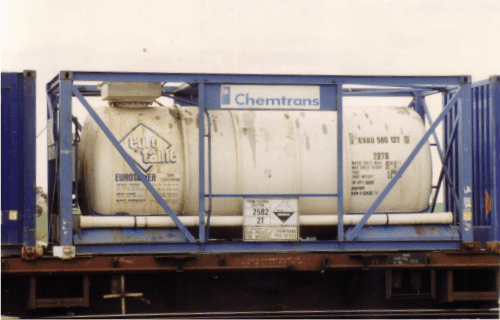 Toxic liquid chemicals being trucked through the Blue Mountains World Heritage Area
Toxic liquid chemicals being trucked through the Blue Mountains World Heritage Area
.
The New South Wales Government decision in the late 1990s to permit 19-metre B-doubles to operate along the Great Western Highway was recognised by many informed Blue Mountains residents as the thin end of the wedge to encourage bigger and faster trucks and to extend Sydney sprawl.
Its planning minister in 2008, Frank Sartor, famously heralded:
.
“Few understand how much transport influences land use patterns. Transport leads land use. Once an expressway or railway is built, it is easy to change the zoning and development laws to increase the population along the corridor.”
.
~ Frank Sartor, NSW Planning Minister, Sydney Morning Herald, 20080929, p11.
.
The Greater Blue Mountains is a vast forested wilderness covering over one million hectares, characterised by ancient sandstone tablelands and escarpments, ancient temperate eucalypt forest types, rainforests, heathlands and swamps containing rare and endemic flora and ecological communities. It was formally inscribed on the World Heritage List on 29 November 2000 and constitutes one of the largest and most intact tracts of protected bushland in Australia.
.
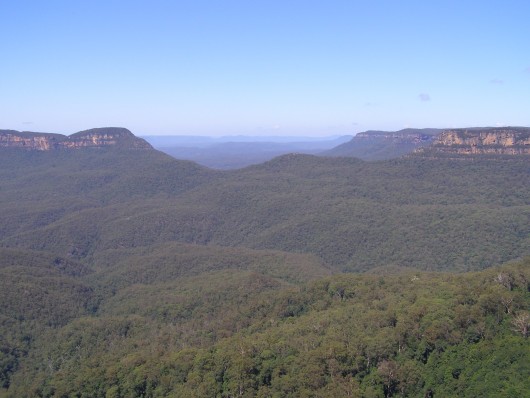 Jamison Valley wilderness and beyond
Blue Mountains World Heritage Area
[Photo by Editor, 20130307, Photo © under ^Creative Commons,
click image to enlarge] Jamison Valley wilderness and beyond
Blue Mountains World Heritage Area
[Photo by Editor, 20130307, Photo © under ^Creative Commons,
click image to enlarge]
.
Along the headwaters of the Jamison Valley above Wentworth Falls, the Jamison Creek flows as a stormwater drain underneath the Great Western Highway.
On or about 7th July 2012, a large quantity of toxic pyrethrin, used as a fumigation pesticide, was dumped into the creek resulting in extermination of all aquatic wildlife downstream and into the World Heritage below. [Source: ‘Health risk posed by Wentworth Falls creek, 20120711, Blue Mountains Gazette newspaper, ^http://www.bluemountainsgazette.com.au/story/273589/health-risk-posed-by-wentworth-falls-creek/]
A year on and still no prosecution has been made against the culprit known by both the local council and the EPA. The contamination could easily have come from the overturning of one of the many trucks that ply the highway now carting toxic chemicals, nudging 90kph.
The Great Western Highway winds its way over the central plateau ridgeline of the Blue Mountains east to west from Sydney. In every respect, the Greater Blue Mountains World Heritage Area is juxtaposed downstream of this highway.
.
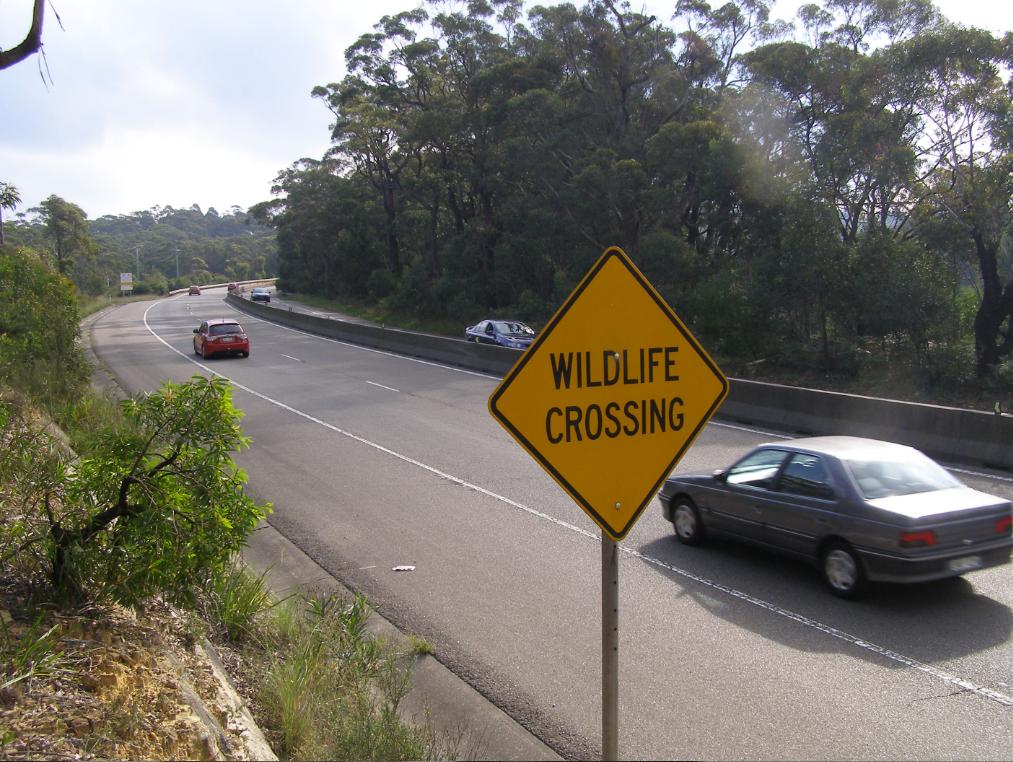 Great Western Highway at Boddington Hill before the Trucking Expressway conversion
The notorious greenwashing sign
[Photo by Editor, 20100327, Photo © under ^Creative Commons]
Great Western Highway at Boddington Hill before the Trucking Expressway conversion
The notorious greenwashing sign
[Photo by Editor, 20100327, Photo © under ^Creative Commons]
.
Increasingly, the Great Western Highway is becoming dominated by larger trucks and an increasing frequency of B-Double Trucks carting sand and soil, containers, palletised freight, heavy machinery and bulk liquids. Transport companies are not delivering to the Blue Mountains; they are transiting through the Blue Mountains for destinations far beyond including Perth and Darwin.
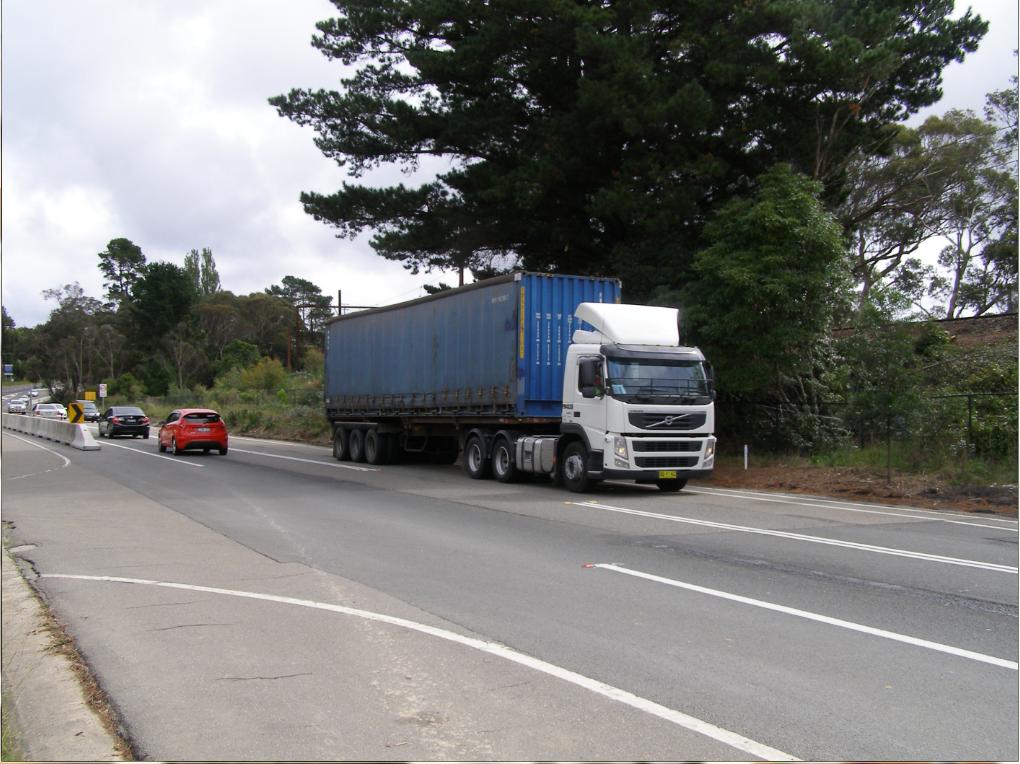 One of the many thousands of larger trucks that now dominate the Great Western Highway
Political lobbying by trucking companies continues to be the prime driver for the multi-billion conversion of this regional highway into a 4-laned interstate Trucking Expressway nudging 90kph.
[Photo by Editor at Bullaburra looking west, 20130406, Photo © under ^Creative Commons] One of the many thousands of larger trucks that now dominate the Great Western Highway
Political lobbying by trucking companies continues to be the prime driver for the multi-billion conversion of this regional highway into a 4-laned interstate Trucking Expressway nudging 90kph.
[Photo by Editor at Bullaburra looking west, 20130406, Photo © under ^Creative Commons]
.
However, local Blue Mountains supporters of this website have informed us that recently the trend is worse, with chemical tank containers now being sighted. The company transporting these bulk chemicals is Chemtrans, a subsidiary of corporate trucker, Scott Corporation, based in Sydney’s west industrial suburb of Padstow.

The tanks display hazardous warnings on the sides.
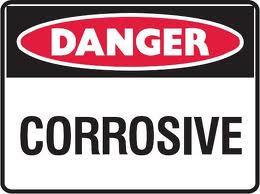
What chemicals are being trucked over the Blue Mountains anyway?
.
-
Sulphuric Acid?
-
Phosphoric Acid?
-
Anhydrous Ammonia?
-
Vinyl Chloride Monimor?
.
Kills Nature
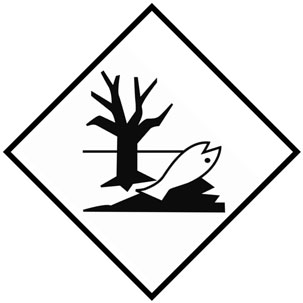
How can this be? What if there is a crash and a spill?
.
With substandard toxic containment infrastructure, World Heritage dies.
.
The Great Western Highway is not designed to contain large flash runoff from storms, let alone contain chemical spills toxic to ecology from entering the downstream headwaters and water courses that flow from the ridgeline down into the surrounding Greater Blue Mountains World Heritage Area.
.
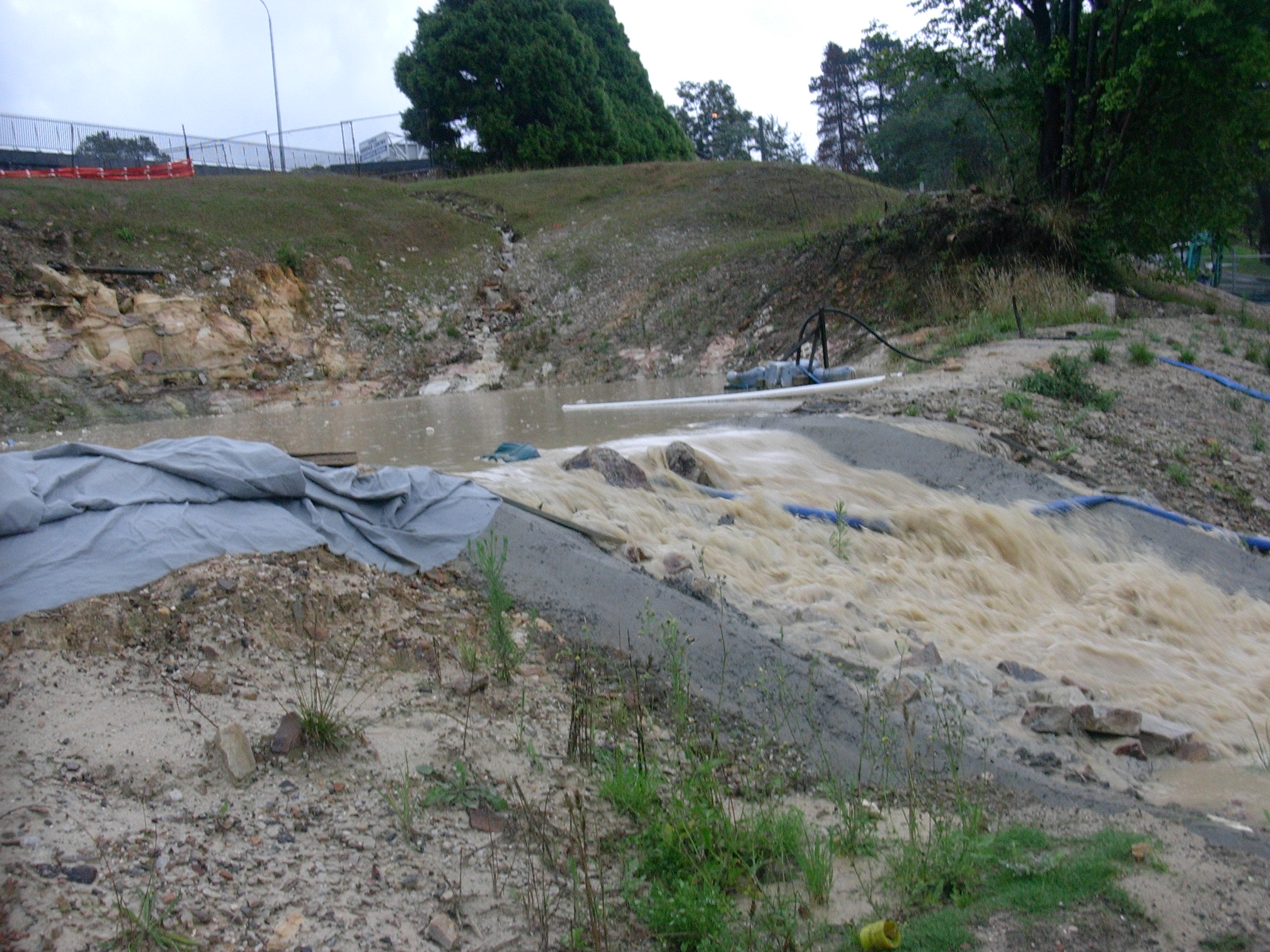 The notorious Leura Retention Basin overflowing during the construction of the Trucking Expressway in 2006
The NSW Government allowed hundreds of tonnes of piled construction sand to wash into and fill the surrounding watercourses and into the World Heritage Area
The then RTA Project Manager, Iain MacLeod, tried excuse the seasonal frequent and heavy rainfall as ‘One in a Hundred Year Events’
[Photo by Editor at Leura north side of highway, 20060116, Photo © under ^Creative Commons]
The notorious Leura Retention Basin overflowing during the construction of the Trucking Expressway in 2006
The NSW Government allowed hundreds of tonnes of piled construction sand to wash into and fill the surrounding watercourses and into the World Heritage Area
The then RTA Project Manager, Iain MacLeod, tried excuse the seasonal frequent and heavy rainfall as ‘One in a Hundred Year Events’
[Photo by Editor at Leura north side of highway, 20060116, Photo © under ^Creative Commons]
.
So when did the NSW Government give permission for bulk toxic chemicals to be transported through the Blue Mountains? What community consultation did the government not engage in? What legislative safety and governance restrictions were not enacted?
.
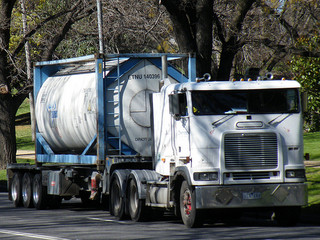  . .
She’ll Be Right, eh Barry O’Farrell?
.
..Just like when in May this year, a FULLY-LADEN DOUBLE FUEL TANKER overturned in a short, straight, three-laned section of the highway between Katoomba and Medlow Bath in the early hours of Sunday, May 12. The giant rig owned by Orange-based Ron Finemores Transport was being driven west when it veered onto the road shoulder and overturned down an embankment, coming to rest with the twin tankers upside down.
She’ll Be Right, eh Barry O’Farrell?
.
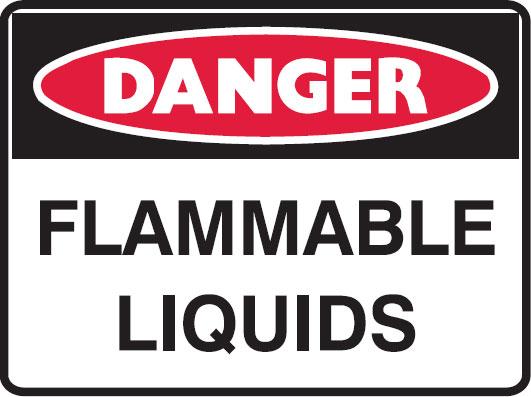
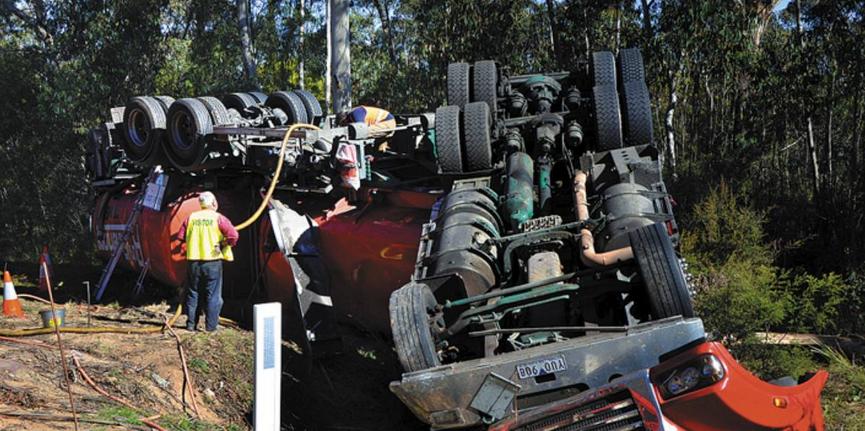 The scene at Sunday morning’s truck crash near Medlow Bath.
Driver fatigue is suspected as a possible cause of the smash.
[Source: Photo: Len Ashworth, Lithgow Mercury, in article ‘Lucky escape for truck driver, 20130515, by Len Ashworth, Blue Mountains Gazette newspaper, ^http://www.bluemountainsgazette.com.au/story/1500162/lucky-escape-for-truck-driver/]
The scene at Sunday morning’s truck crash near Medlow Bath.
Driver fatigue is suspected as a possible cause of the smash.
[Source: Photo: Len Ashworth, Lithgow Mercury, in article ‘Lucky escape for truck driver, 20130515, by Len Ashworth, Blue Mountains Gazette newspaper, ^http://www.bluemountainsgazette.com.au/story/1500162/lucky-escape-for-truck-driver/]
.
The tanker overturned in bushland just upstream from the Cascade Water Catchment that stores drinking water for the region and in which fines for tresspass are $44,000.
But Ron Finemores Transport was not fined the $44,000. Why not?
.
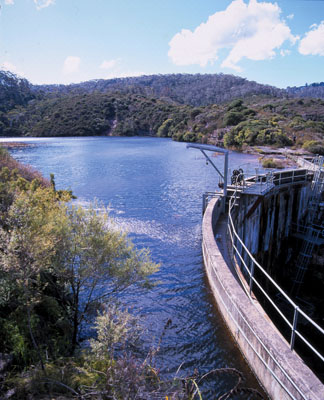
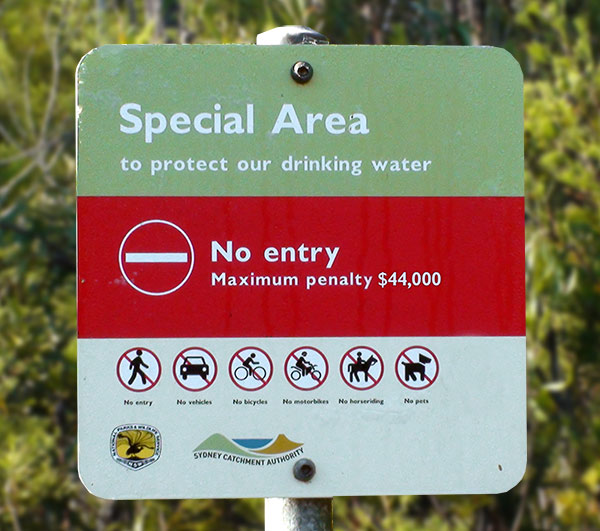
.
Sydney Water ‘Special Areas’ prohibit public entry in order to protect water quality.
This benefits the community by:
- Protecting water quality
- Protecting large areas of bushland and plant and animal habitats
- Protecting threatened plants and animal species
- Preserving evidence of Aboriginal occupation dating back many thousands of years, and
- Preserving evidence of non-Aboriginal exploration, early settlement and phases of development such as forestry, mining and dam building.
.
[Source: Sydney Catchment Authority, NSW Government, ^http://www.sca.nsw.gov.au/the-catchments/special-areas]
.
What Next? Trucking nuclear waste through the Blue Mountains?
.
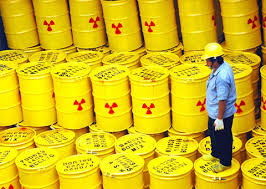
Don’t put it past them. There are plans afoot to truck radioactive waste and parts of Australia’s old 1960s nuclear reactor out of Sydney under plans to clean up the Lucas Heights nuclear facility and develop a national hazardous-waste dump in the outback.
The trucks will necessarily pass by residential homes carrying a radioactive high-flux reactor’ and spent fuel rods.
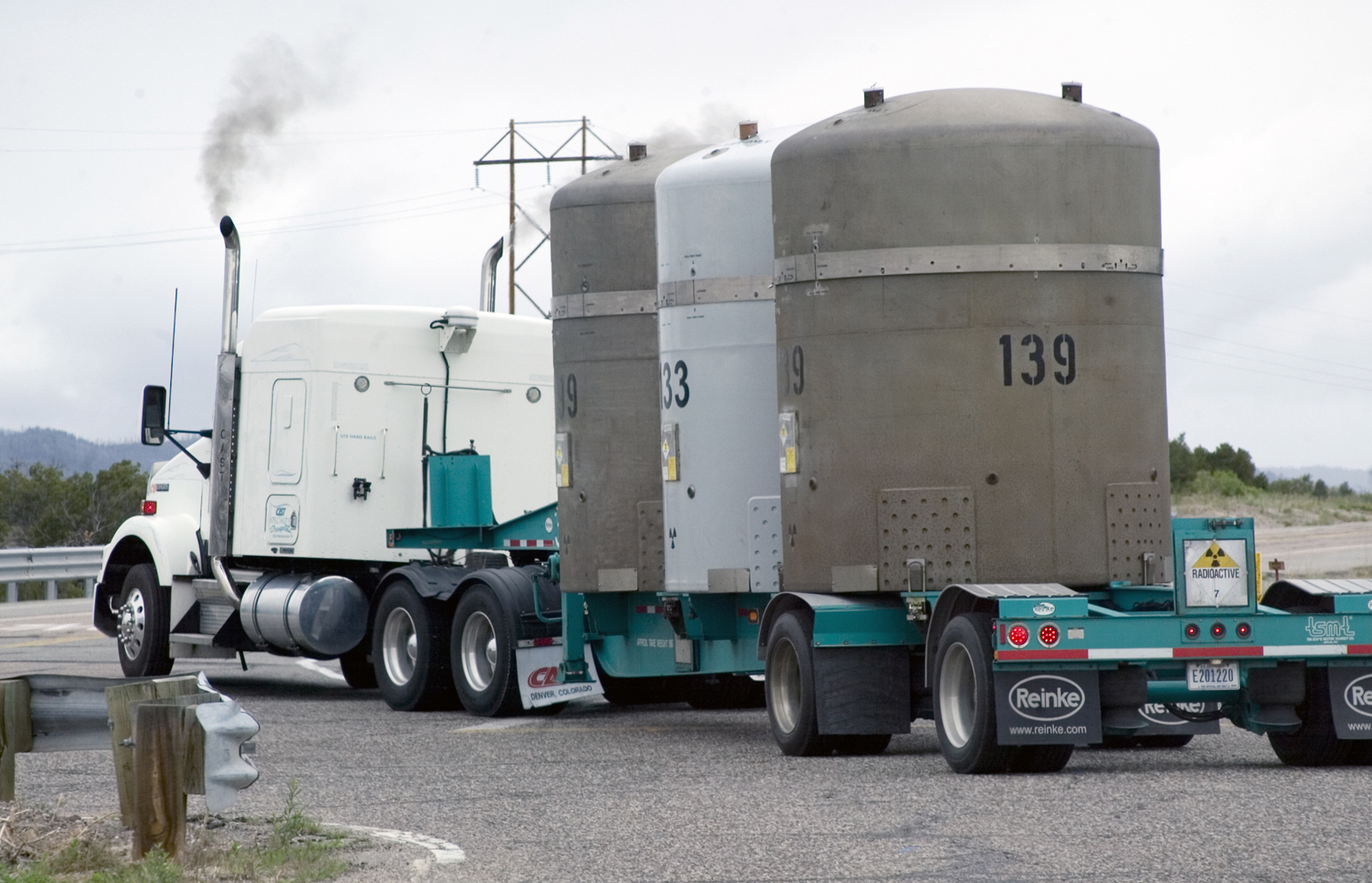
The Sources of Radioactive Waste
.
- The Australian Nuclear Science and Technology Organisation, which manages the Lucas Heights Nuclear Reactor, has been given $28.7 million to prepare for the move. The four-year funding package will pay for ‘pre-disposal conditioning of existing radioactive waste in preparation for long-term underground storage, including radioactive contaminated buildings and infrastructure at Lucas Heights.
- Also planned to be trucked is nuclear contaminated soil waste from the former uranium smelter site at Hunters Hill.
- Also planned to be trucked is spent fuel rods after they were reprocessed at a nuclear facility in France.
.
The target waste disposal site is on remote Aboriginal land near Muckaty, 800 km south of Darwin (specifically 100 km north of Tennant Creek) in the Northern Territory. The most direct trucking route, some 2,387 km from Lucas Heights, is via the Great Western Highway through the Blue Mountains World Heritage Area.
The only other feasible trucking route is via the Pacific Highway to Newcastle and then north-west along the Golden Highway, which is unlikely because it would pass through more densely populated communities.
The Australian Government approved its Radioactive Waste Dump at Muckaty in the Northern Territory under the National Radioactive Waste Management Bill 2010, passed through the Senate on 13 March, 2012.
This was in blatant contradiction to years of resistance and opposition from from the remote and marginalised Muckaty indigenous community and supportive environmental groups. Traditonal Owners maintain that both the Northern Land Council and the Commonwealth failed to accurately identify, consult with and receive their consent and are seeking to reverse the decision.
What’s new?
Responsible radioactive waste management needs an approach based on:
- Non-imposition
- Community consent
- Scientific and procedural rigour.
.
None of the approaches was observed during the opaque transition of this proposal into law.
.
[Source: ‘Nuclear waste on the move in clean-up’, 20130516, by Heath Aston, Political reporter, Sydney Morning Herald, ^http://www.smh.com.au/nsw/nuclear-waste-on-the-move-in-cleanup-20130515-2jmu5.html; and ‘Muckaty radioactive dump’, not dated (2013?), by Manuwangku, Australian Conservation Foudnation, ^http://www.acfonline.org.au/be-informed/northern-australia-nuclear/muckaty-radioactive-dump]
.
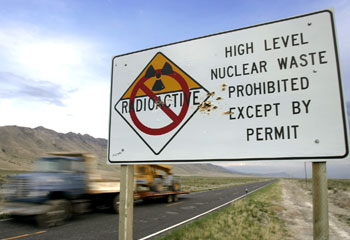 The Australian Government’s preferred site for Nuclear Waste
is Muckaty Station, near Tennant Creek,
trucked from Lucas Heights, Botany and Hunters Hill through the Blue Mountains.
The Australian Government’s preferred site for Nuclear Waste
is Muckaty Station, near Tennant Creek,
trucked from Lucas Heights, Botany and Hunters Hill through the Blue Mountains.
.
In 1997, a train carrying 180 tonnes of high-level nuclear waste derailed in France. In 2004, a truck spilled strontium-90 onto Highway 95 in Roane County, Tennessee.
.
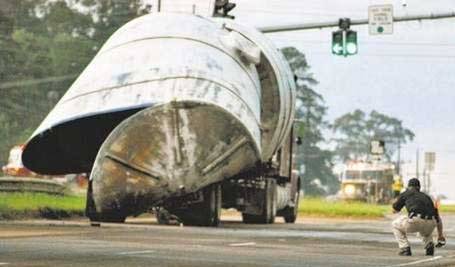
She’ll be Right!
.
America 2011:
.
<< With the passage of Senate Bill 1504 in the Texas Senate (Texas Low-Level Radioactive Waste Disposal Compact) , radioactive waste could soon be barreling down Texas highways and through our neighborhoods by way of Interstate 10 through Houston, San Antonio and El Paso; Interstate-20 and Interstate-30 though Dallas and Forth Worth, Midland and Odessa ; and Interstate-27 though Lubbock and Amarillo.
The greatest risk we face is having an accident with vehicles containing waste. Cleanup estimates range from $100 to a billion dollars or more according to the U.S. Department of Energy, but the state of Texas has set aside only $500,000. Taxpayers would pay the rest.
And what if an accident happens next to a school, playground or hospital? Don’t we want to make sure that our local emergency responders have the training and equipment needed to handle an accident where a truck is leaking radioactive waste?
Thanks to Senator Seliger’s leadership, there have been some important protections added in, but a number of loopholes remain that dramatically increases the risk and liability assumed by Texas taxpayers. There is still a chance to close these loopholes. This bill goes to the Texas House floor next week and Texans should ask their legislators to make sure that there is an immediate thorough analysis of transportation risks, costs of cleaning up contamination from accidents or leaks, and waste capacity at the site.
As the Japanese nuclear disaster has taught us, cleaning up after radioactive waste can be a costly and dangerous process. We urge the house to make sure we have protective measures in place before an accident. >>
.
[Ed: The Texas Senate Bill 1504 was made effective 9th January 2011]
.
[Source: Radioactive Waste Could Be Rumbling Through Your Town Unless State Legislators Close Loopholes in SB 1504, 20110414, by Citizen Carol,
^http://texasvox.org/2011/04/14/radioactive-waste-could-be-rumbling-through-your-town-unless-state-legislators-close-loopholes-in-sb-1504/]
.
Tags: B-Double Trucks, Blue Mountains, Chemtrans, Great Western Highway, Greater Blue Mountains World Heritage Area, Muckaty, National Radioactive Waste Management Bill 2010, nuclear waste, Radioactive Waste Dump, Ron Finemores Transport, Scott Corporation, trucking expressway, Trucking nuclear waste
Posted in Threats from Pollution, Threats from Road Making | No Comments »
Add this post to Del.icio.us - Digg
Saturday, June 22nd, 2013
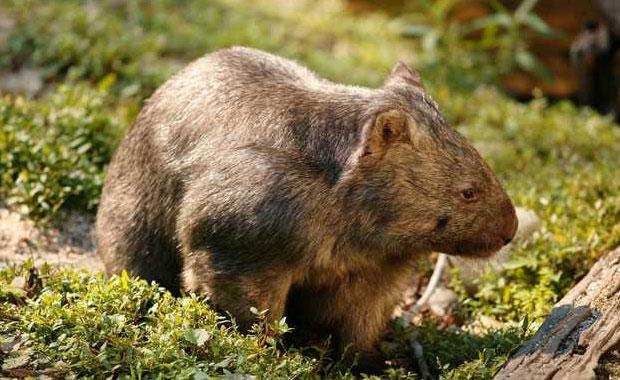 Common Wombat
(Vombatus ursinus)
A legally protected native animal throughout Australia
[Source: Healesville Sanctuary, Victoria, Zoos Victoria,
^http://www.zoo.org.au/healesville/animals/wombat] Common Wombat
(Vombatus ursinus)
A legally protected native animal throughout Australia
[Source: Healesville Sanctuary, Victoria, Zoos Victoria,
^http://www.zoo.org.au/healesville/animals/wombat]
.
June 2013:
.
Tragically, a native Wombat has been deliberately poisoned this month in Mount Wilson in the Blue Mountains, and so the New South Wales National Parks and Wildlife Service (NPWS) is appealing for information from the local community.
Ranger Neil Stone of the NPWS Blue Mountains Region:
“A Wombat was recently found at Mount Wilson village (population 220), suffering from what a local veterinarian thinks was poisoning and sadly the animal had to be euthanized.
“Wombats become unpopular with landholders when they damage fences and infrastructure or trample on gardens. But there are methods, including installing Wombat Gates, that enable Wombats to pass through properties without damaging them.”
.
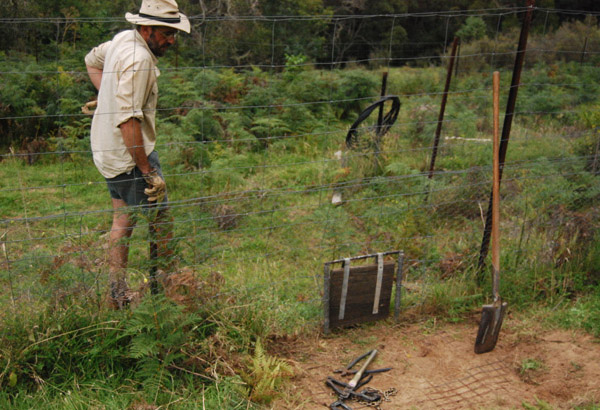 An example of a purpose-built Wombat Gate
If one can afford property at exclusive Mount Wilson with average prices currently $750,000 [^Source]
then one can afford to contribute a few purpose-built Wombat Gates across their property,
constructed by wildlife experts who know what they are doing!
[Photo Source: Rocklily Wildlife Refuge, Taralga, NSW,
^ http://rocklilywombats.com/blog/rocklily-history/] An example of a purpose-built Wombat Gate
If one can afford property at exclusive Mount Wilson with average prices currently $750,000 [^Source]
then one can afford to contribute a few purpose-built Wombat Gates across their property,
constructed by wildlife experts who know what they are doing!
[Photo Source: Rocklily Wildlife Refuge, Taralga, NSW,
^ http://rocklilywombats.com/blog/rocklily-history/]
.
NPWS Ranger Neil Stone:
“Wombats are extremely strong and determined, constructing their burrows (often under homes) to escape from the heat and to hide from predators (typically domestic and feral dogs nowadays). The burrows can be up to 30 metres long which can cause conflict between Wombats and humans.”
“Wombats and all other native animals are protected under the National Parks and Wildlife Act 1974 and Regulations and it is illegal to harm them without a licence. There are fines and possible imprisonment for people found to have intentionally harmed native wildlife.”
.
[Source: ‘Not so divine: Wombat dies in suspected poisoning’, 20130612, Blue Mountains Gazette newspaper (print only), p.15]
.
Wildlife Poisoning is Animal Harm
.
Wombats being mammals are sentient animals, meaning that they feel emotion and pain. An animal is ‘sentient‘ if it is capable of being aware of its surroundings, its relationships with other animals and humans, and of sensations in its own body, including pain, hunger, heat or cold.
Individuals who harm animals including the harming of wildlife such as by poisoning, tend to harbour a personality disorder. Statistically, animal abusers are five times more likely to go on to commit violent crimes against people.
Deviant behaviors like animal abuse generally originate from a traumatic childhood. The American Psychiatric Association considers animal cruelty as one of the diagnostic criteria of conduct disorder.
The fourth edition of the Diagnostic and Statistical Manual of Mental Disorders (DSM) defines conduct disorder as “a repetitive and persistent pattern of behavior in which the basic rights of others or major age appropriate societal norms or rules are violated.” Conduct disorder is found in those who abuse animals and abuse people.
Clinical evidence indicates that animal cruelty is one of the symptoms usually seen at the earliest stages of conduct disorder, often by the age of eight. This information has only recently been included in the DSM so some psychologists, psychiatrists, and social workers are just now becoming aware of it. Many psychological, sociological and criminology studies in recent decades have clearly shown that violent offenders have adolescent histories of serious and repeated animal cruelty.
Director of People for the Ethical Treatment of Animals (PETA) Asia, Jason Baker, has said, “We believe that cruelty to animals is not inherent, but learned. That being said, teaching kindness and respect for animals – in our schools and homes – will foster empathy, the ability to understand what someone else feels.” He added, “Incorporating the simple concepts of kindness and respect into our daily lives and teaching our children to respect and protect even the smallest and most despised among us will help kids value one another.”
The link between animal abuse and interpersonal violence is becoming so well established that many U.S. communities now cross-train social-service and animal-control agencies in how to recognize signs of animal abuse as possible indicators of other abusive behaviors. >>
.
[Source: ‘Animal Cruelty Syndrome’, by Canadians for Animal Welfare Reform, ^http://cfawr.org/animal-abuse.php]
.
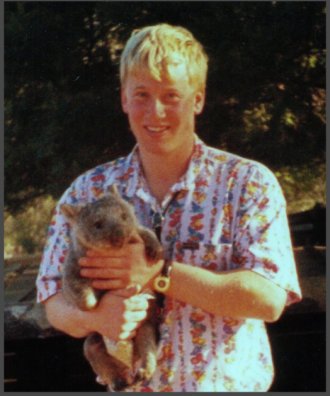 Martin Bryant as a teenager nursing a juvenile Wombat
Bryant reportedly tortured animals as a child.
In 1996, at age 29 Bryant murdered 35 people and injured 21 others
at Port Arthur Tasmania Martin Bryant as a teenager nursing a juvenile Wombat
Bryant reportedly tortured animals as a child.
In 1996, at age 29 Bryant murdered 35 people and injured 21 others
at Port Arthur Tasmania
.
Penalties in NSW for Harming protected Fauna
.
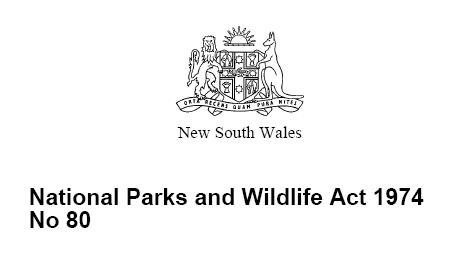
.
Sect 98 ‘Harming protected fauna, other than threatened species, endangered populations or endangered ecological communities’
.
(Ed: i.e. Wombats)
.
(1) In this section, protected fauna does not include threatened interstate fauna, threatened species, endangered populations, endangered ecological communities, or locally unprotected fauna under section 96.
(2) A person shall not:
(a) harm any protected fauna, or (a1) harm for sporting or recreational purposes game birds that are locally unprotected fauna, or
(b) use any substance, animal, firearm, explosive, net, trap, hunting device or instrument or means whatever for the purpose of harming any protected fauna.
.
Maximum penalty:
.
(a) 100 penalty units and, in a case where protected fauna is harmed an additional 10 penalty units in respect of each animal that is harmed, or
(b) imprisonment for 6 months, or both. >>
.
Note: As at 2013, 1 penalty unit in NSW equates to $110. So 100 +10 penalty units incurs a fine of $12,100 per protected Wombat harmed [Calculation: (100 + 10) x $110]
.
[Sources: National Parks and Wildlife Act 1974, No 80, Section 98, (historical version but this section still current), pp 149-150, ^http://www.environment.nsw.gov.au/legislation/NationalParksAndWildlifeAct1974.htm ; ^http://en.wikipedia.org/wiki/Penalty_units]
.
.
.
So who killed the Mt Wilson Wombat?
.
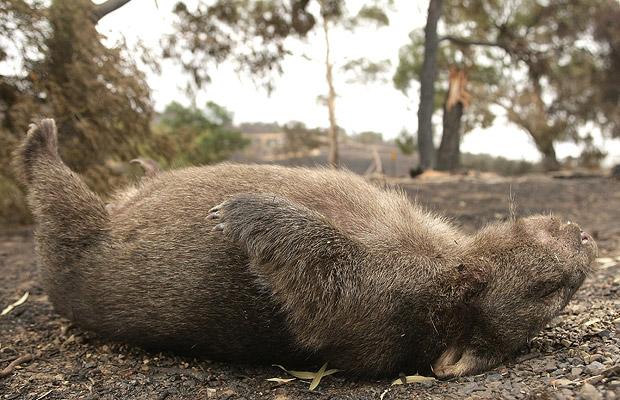 A common Wombat sight
…”Just Roadkill”
A common Wombat sight
…”Just Roadkill”
.
It is likely that Mount Wilson’s Wombat was poisoned by an ignorant and frustrated local landholder. He is one of just a few hundred residents living at remote Mount Wilson village, and probably he is some arrogant newcomer with no respect for the natural environment or its resident wildlife who were there first. It is extremely rare for a female to commit wildlife poisoning.
The perpetrator is likely to be someone holding an Anglicised mindset toward rural property, desiring the exotic deciduous garden and with a phobia towards the natural Australian bush. Whereas the more established residents tend to be respectful towards the special environment in which they live and have become more accommodating towards the place’s resident wildlife.
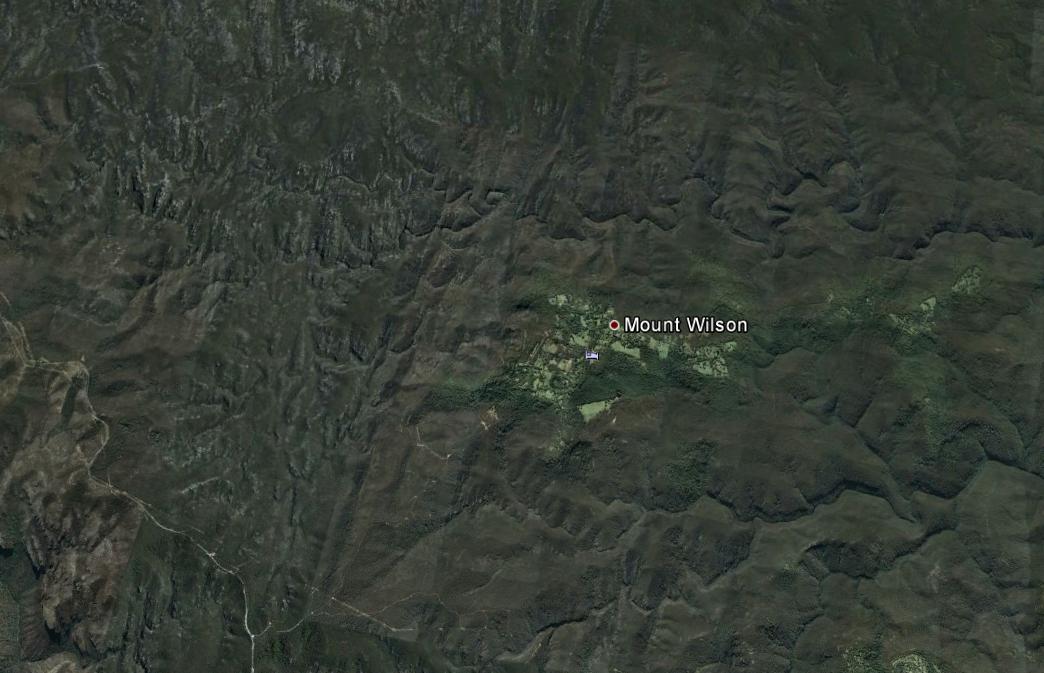 Mount Wilson lies in a remote forested wilderness region of the Blue Mountains
And the native Wombats have lived there thousands of years before
Colonial Deforestation
Housing Development
Anglicised Garden Romanticism
[Source: Google Earth]
(click image to enlarge) Mount Wilson lies in a remote forested wilderness region of the Blue Mountains
And the native Wombats have lived there thousands of years before
Colonial Deforestation
Housing Development
Anglicised Garden Romanticism
[Source: Google Earth]
(click image to enlarge)
.
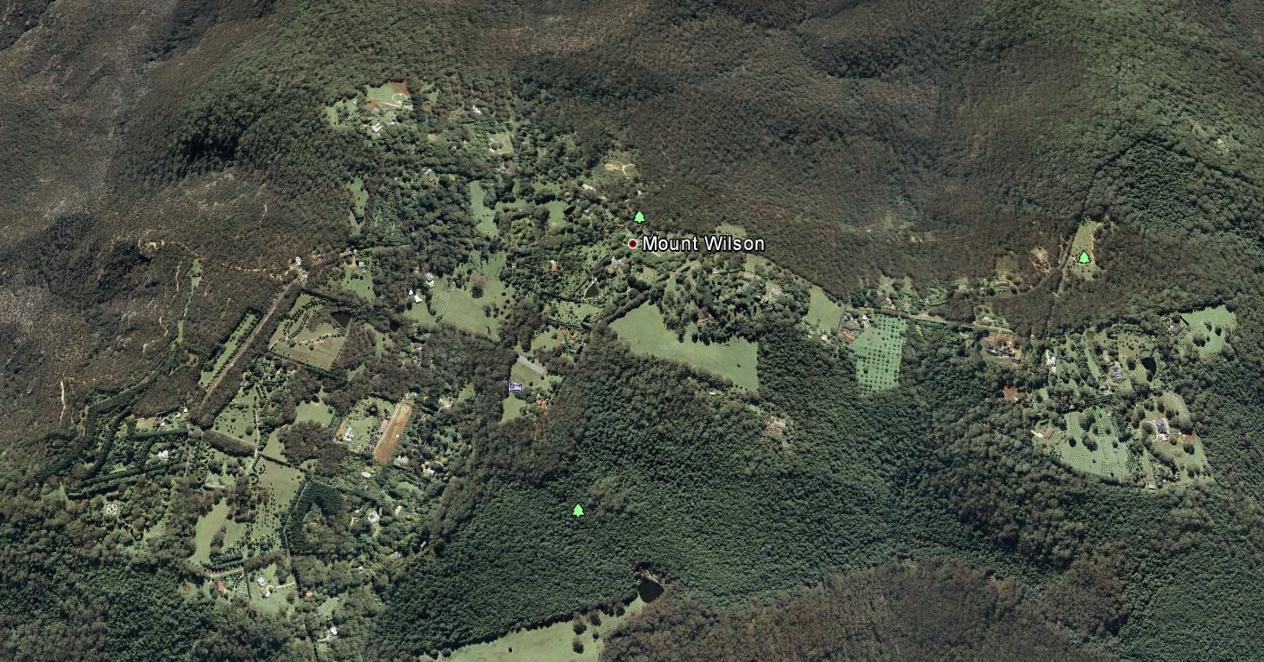 Mount Wilson
Best described as a remote hilltop residential hamlet
Situated on an ancient volcanic hill
Since the 1870s, logged, burned and settled by English colonists
amongst the ‘Wombat Holes’
[Source: Google Earth]
(click image to enlarge)
Mount Wilson
Best described as a remote hilltop residential hamlet
Situated on an ancient volcanic hill
Since the 1870s, logged, burned and settled by English colonists
amongst the ‘Wombat Holes’
[Source: Google Earth]
(click image to enlarge)
.
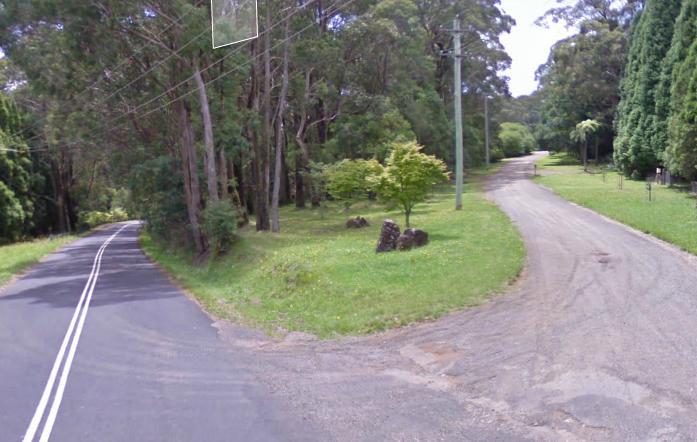 Hillcrest Lane (right), Mount Wilson Hillcrest Lane (right), Mount Wilson
[Source: Google Maps, 2013]
.
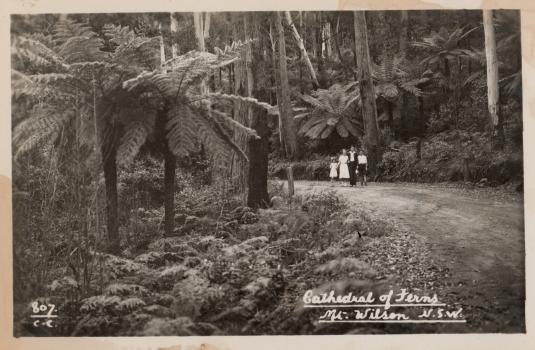 Mount Wilson before the Anglicising
[Source: Mt Wilson/Mt Irvine Historical Society, ^http://www.mtwilson.com.au/]
Mount Wilson before the Anglicising
[Source: Mt Wilson/Mt Irvine Historical Society, ^http://www.mtwilson.com.au/]
.
Consistent with the profile of the typical member of the Game Council NSW, the perpetrator is likely to be a middle-aged or older male Babyboomer approaching 65, having an anthropocentric worldview of Nature, and an evangelistic belief that economic growth and personal wealth accumulation is a right – Wombats being collateral damage in rural housing development.
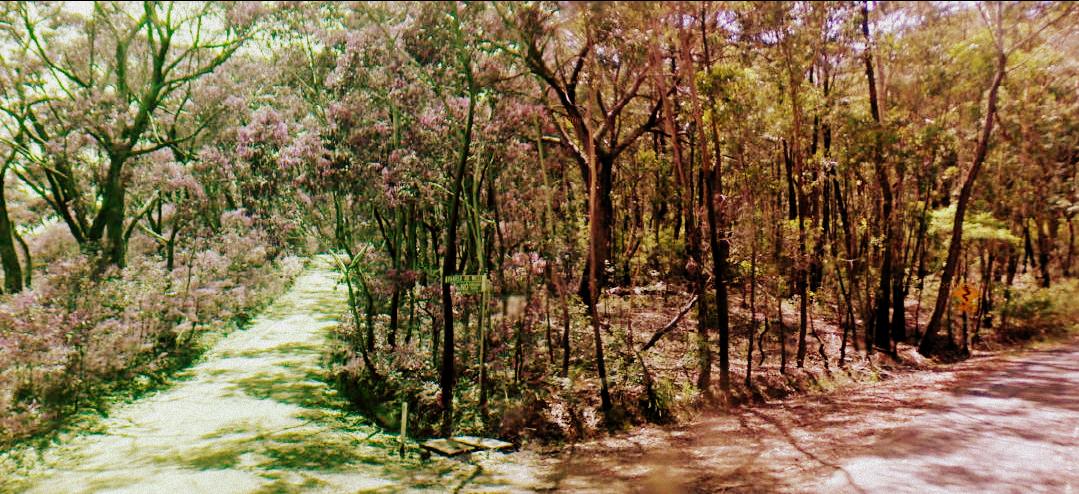 Mount Wilson bushland
Mount Wilson bushland
.
The perpetrator has not yet been confirmed, and anyone with information about this harmful offence is asked to contact the closest NPWS base at the Blue Mountains Heritage Centre in nearby Blackheath.
.
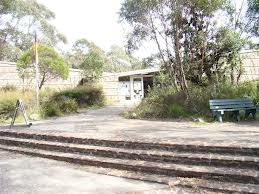 NPWS Blue Mountains Heritage Centre
Located towards the eastern end of Govetts Leap Road
outside the nearby township of Blackheath NPWS Blue Mountains Heritage Centre
Located towards the eastern end of Govetts Leap Road
outside the nearby township of Blackheath
.
.
.
The ‘Common‘ Wombat?
.
The Common Wombat (Vombatus ursinus) is also known as the Coarse-Haired Wombat or Bare-Nosed Wombat. In the case of the Bare-Nosed Wombat, this reference to its nose, distinguishes it from its other two subspecies, the Southern Hairy-Nosed Wombat (Lasiorhinus latifrons) and the endangered Northern Hairy-Nosed Wombat (Lasiorhinus krefftii).
The ‘Common Wombat‘ is a nocturnal marsupial native to south eastern Australia and is found in small sections of southeast tip of Queensland, eastern New South Wales, eastern and southern Victoria, and south-east South Australia. They are common throughout Tasmania and also on Flinders Island in Bass Strait.
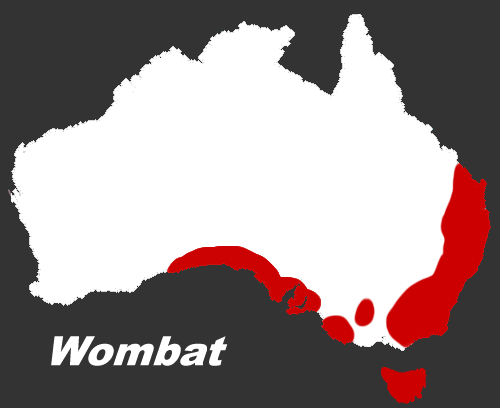
The head of the Common Wombat is more rounded than that of the hairy-nosed subspecies. Their short ears are triangular and slightly rounded. Their nose is large, shiny black and furless. Their fur is coarser, thicker and longer than that of the Hairy-nosed Wombats, better suited to a colder, wetter habitat. Fur colour varies from sandy to brownish black or even grey, sometimes flecked.
.
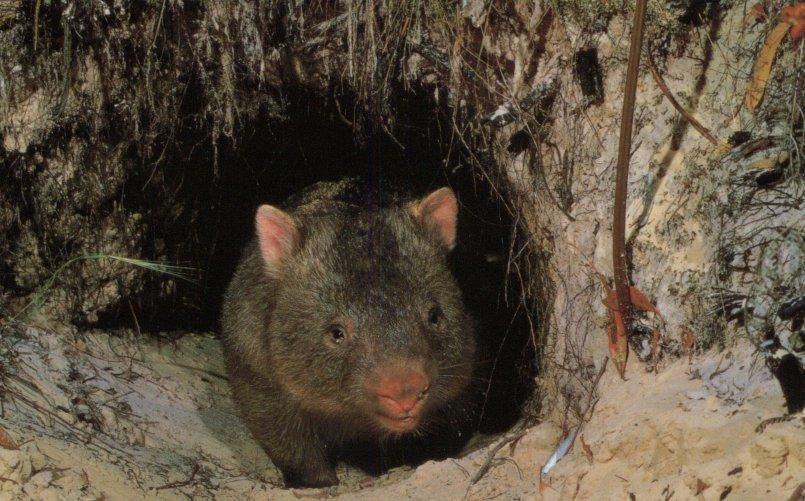 Bare-Nosed Wombat
a more respectful naming than ‘Common’ Bare-Nosed Wombat
a more respectful naming than ‘Common’
.
Wombats have short legs, and the second and third toes of the hind feet are fused, with a double claw used in grooming. Wombats are solid and stocky, with short legs and tail. Their front legs and shoulders are powerful. Their front feet are large, with bear-like long claws. They use their front legs for digging burrows. The dirt is pushed to one side and the Wombat backs out, moving loose dirt with front or back paws. It grows to an average of 98 cm long and up to a healthy weight of 26 kg.
Wombats are stilll classed as ‘least concern’ by the International Union for Conservation of Nature and Natural Resources (on the IUCN ‘red list’). [Ed: So were the Koala and Tasmanian Devil until recently].
At Healesville Sanctuary in Victoria, more than 2,000 sick and injured native animals treated each year including Wombats at its Australian Wildlife Health Centre.
[Source: Healesville Sanctuary, Zoos Victoria, Victorian State Government, ^http://www.zoo.org.au/healesville/animals/wombat]
.
 Situated on Badgers Creek
A place of inspiration to this Editor,
when visited as a child. Situated on Badgers Creek
A place of inspiration to this Editor,
when visited as a child.
.
Although Wombats have been named by European Australians as the ‘Common Wombat‘, their numbers and their existence value does not translate to anyone treating them as commonplace.
Common Wombats were once widespread from south-eastern Queensland, through NSW along the Great Dividing Range and most of Victoria. Now they have a fragmented distribution in NSW, being most abundant in the south-eastern parts of the state. Remaining populations are under continued pressure from land clearing, road mortality, disease and illegal shooting. These pressures may be acute for some local populations.
While the word ‘Wombat’ is derived from the Aboriginal name for the animal, ‘common’ was added at a time when these animals were plentiful and the Australian bush landscape relatively less destroyed by colonial settlement. Wombats were likened to European Badgers by the early colonists.
We prefer the more respectful name, ‘Bare-Nosed Wombat‘.
.
In 2010, university student Nikki Selles, from the School of Natural Sciences at the University of Western Sydney, undertook a field fauna study on Wombats in the Mt Wilson and Mt Irvine area. Due to the behaviour of slow moving, ground-dwelling Wombats being sensibly shy and noctural, Selles used camera-trap data to identify their habitat and distribution in the urban-bush interface.
Results ought to be obtainable from the university.
[Source: Mount Wilson and Community Newsletter, May 2010, ^http://www.mtwilson.com.au/images/stories/MWPA_Newsletters/May_2010.pdf]
.
While the Bare-Nosed Wombat is not yet threatened with extinction, the Northern Hairy-Nosed Wombat is endangered. This is mainly due to overgrazing by sheep and cattle destorying their fragile semi-arid habitat across more central Australia, as well as the culture of broadscale hazard reduction and uncontrolled bushfires.
Mount Wilson also provides vital native habitat for fauna species that are recognised as endangered. These include the Sooty Owl (Tyto tenebricosa), the Eastern Bent Wing Bat (Miniopterus schreibersii oceanensis), the Large eared pied bat (Chalinolobus dwyeri), Little John’s Tree Frog (Litoria littlejohni), and the Eastern False Pipistrelle (Falsistrellus tasmaniensis).
.
Living with Resident Wombats
.
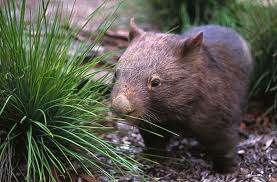 Wombats are locally territorial, like Humans
Try to relocate them, and they will stubbornly resist – even after repeated flood, drought, bushfire and earthquake
Ask any Human who has endured such tempest. Wombats are locally territorial, like Humans
Try to relocate them, and they will stubbornly resist – even after repeated flood, drought, bushfire and earthquake
Ask any Human who has endured such tempest.
.
<<Wombats are an iconic part of the protected fauna of NSW. They are extremely strong and determined animals.
They can build their burrows under Human-introduced houses, driveways and cattle stock routes. This may cause Humans inconvenience and conflict between Wombats and non-Indigenous Humans.
.
But Newcomer Humans need to respect that Wombats were there first.
Who likes Invasion or Displacement?
.
Human-Wombat conflicts can be respectfully resolved and accommodated by wisdom – by learning about the behaviour of Wombats and understanding their habitat needs.
The Bare-Nosed Wombat is the species most frequently found in NSW. They prefer temperate forested areas of the coast, ranges and western slopes. Slopes above creeks and gullies are favoured sites for burrows and they like to feed in grassy clearings, including farm paddocks.
.
Wombat Habitat Needs
.
Wombats construct burrows to escape the heat and hide from predators. They prefer areas where it is easy for them to dig. The burrows can be up to 30 metres long and several metres deep and are usually situated above creeks and gullies and may have multiple entrances. Active burrows are often characterised by fresh cube-shaped droppings and scratch marks as well as freshly dug soil at the burrow entrance. Wombats will often build more than one burrow within their home range of 5 to 25 hectares.
Wombats are mostly solitary animals, but overlapping home ranges can occasionally result in a number of Wombats using the same burrow. Wombats are possessive about their particular feeding grounds and they will mark out these areas by leaving scent trails and droppings. These markings are prominently placed on rocks and logs around the boundaries. If an intruding Wombat encroaches on another’s territory it will be discouraged through a series of snorts and screeches and at times physical aggression.
Breeding occurs year-round with each female typically producing one young. In some areas, however, Wombats are seasonal breeders and may have dependent young in burrows from April to June. Young Wombats take up to 21 months to reach full independence and two years to become sexually mature.
.
Wombat Behaviour
.
Wombats become unpopular with landholders when they damage fences and infrastructure or trample upon gardens. Undetected burrows can be a hazard to livestock as they may trip or fall into burrows and injure themselves.
Many of the problems caused by Wombats can be resolved with some patience and innovation. Landholders willing to share their property with Wombats may find that there are simple solutions to most problems. For example, a post or small strand fence can be used to mark burrows in paddocks or driveways to keep stock away from burrow entrances.
Wombats use the same trails to get to and from their preferred feeding areas. Instead of going around an obstacle, such as a fence, a determined Wombat will try to go through, or under it instead. Installing purpose-built ‘Wombat Gates’ at known Wombat breech points along a fence will allow them to pass through a fence without damaging it. The fence needs to continue to exclude other animals such as wallabies, rabbits and foxes.
Removing the lowest fencing wire (15 cm above ground level) will also allow Wombats to move through an area without damaging the fence. This is a much cheaper option than excluding them completely.
Check first with a Certified National Parks Wildlife Ranger.
.
Excluding wombats from Rural Property
.
It is possible to exclude Wombats from continuing to use a burrow that is under a building but this requires intervention by a Certified National Parks Wildlife Ranger.
.
Increasing Native Vegetation
.
Wombats prefer to burrow in areas of vegetation and rocky debris. Land clearing has forced Wombats to build burrows along creeks and drainage lines where vegetation still exists. Wombats are also often incorrectly blamed for causing erosion, which is more likely due to poor land management practices.
Planting trees and revegetating areas away from creeks can play a vital role in reducing Wombat burrowing activity along creek beds. Retaining existing trees, logs and rocks, and establishing new areas of native vegetation encourages Wombats to construct burrows in less fragile areas and reduces the risk of erosion.
Check first with a Certified National Parks Wildlife Ranger.
.
Trapping or Relocating Wombats Prohibited
.
The trapping and relocation of Wombats is prohibited and attracts heavy fines.
Wombats are territorial animals and if relocated, they are likely to be harassed or even killed by resident Wombats. Wombats are classified as protected fauna under the NSW National Parks and Wildlife Act 1974.
.
Can I bulldoze or infill a Wombat burrow?
.
No! Only inactive Wombat burrows may be destroyed, but each one needs to be first validated by a Certified National Parks Wildlife Ranger.
Bulldozing an active burrow can lead to wombats being buried alive and suffering a slow and painful death. Even if you have located an apparently vacant burrow, you must not fill it in without confirming that it is inactive. Burrow activity can be confirmed by placing sticks across each entrance and checking (every day for at least a week) if these are disturbed.
Remember that if you think you have an inactive burrow, check first with a Certified National Parks Wildlife Ranger.
contact your local National Parks office for expert verification before any action.
.
[Source: NSW Government, ^ http://www.environment.nsw.gov.au/animals/LivingWithWombats.htm#gate]
.
.
.
Further Reading
.
[1] Wombat Gate Design
^http://www.dpiw.tas.gov.au/inter.nsf/Attachments/LBUN-84H7FT/$FILE/Wombat%20gate%20design.pdf
.
[2] Guide to Living with Wombats
[Source: ^ http://www.naturalresources.sa.gov.au/samurraydarlingbasin/plants-animals/native-plants-and-animals/native-animals]
.
[3] National Parks and Wildlife Act (NSW) 1974
^http://www.austlii.edu.au/au/legis/nsw/consol_act/npawa1974247/
.
[4] Wombat Protection Society of Australia
^http://www.wombatprotection.org.au/
.
Why Do Wombats Need Protection?
Lack of Legislative Protection/Enforcement!
<< In Australia native animals are “the property of the Crown”. This means that no-one owns wombats, they can’t be kept as pets and to do anything with them you have to be licensed by government departments.
Government Departments do little to protect or help wombats. Most research and all welfare (rescuing injured wombats, raising the joeys of mothers killed in collisions with vehicles, removing wombats from unsuitable places) is undertaken by voluntary organizations. While penalties exist if someone is found to hurt or kill a wombat, the same government departments charged with wombat care issue permits to farmers to cull wombats. Sadly, there is often no check whether this is necessary, whether it is done humanely or any insistence that alternative options be employed before issuing such permits.
On the other hand although penalties exist for the illegal killing of wombats, such killing occurs every night where on a farms they are shot, buried alive and gassed and on the highways of Australia vehicles indiscriminately drive directly at wombats without penalty. Live joeys left in their dead mother’s pouches die slowly and a lack of public education means few Australians understand how to rescue a joey still living after its mother falls victim to road kill. >>
.
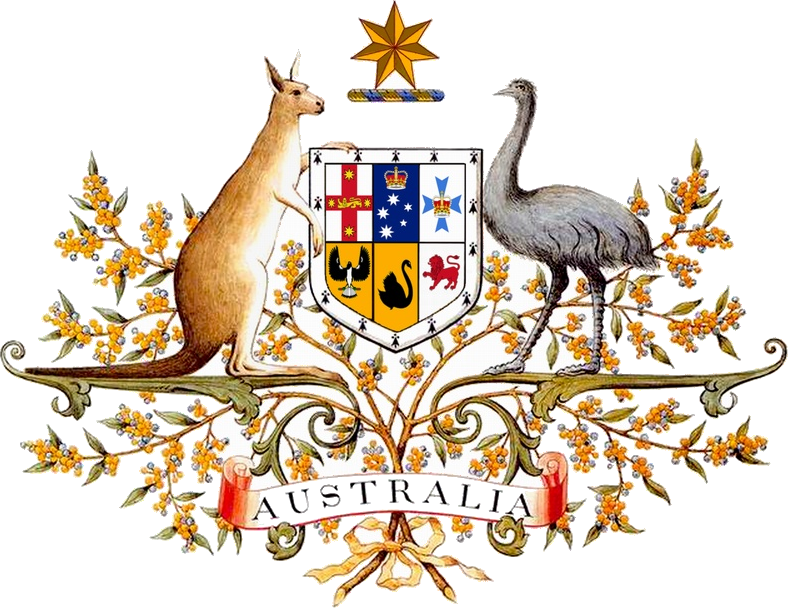 The Crown
Disinterested in protecting Australian wildlife
The kangaroo and emu images are but token symbolism The Crown
Disinterested in protecting Australian wildlife
The kangaroo and emu images are but token symbolism
.
[5] The Wombat Foundation
^http://www.wombatfoundation.com.au/
.
<<The Wombat Foundation is a charitable organisation set up to support activities that aim to bring the Northern Hairy-nosed Wombat back from the brink of extinction.
The Northern Hairy-nosed Wombat is one of the world’s most endangered species – it is more endangered that the Panda.
In the 1980s, there were as few as 35 wombats remaining on the planet – all at Epping Forest National Park in central Queensland. A second population was established at Richard Underwood Nature Refuge in southern Queensland in 2009. At last count, in 2010, there were a total of 176 wombats across the two sites. Since then, the population has continued to grow: in 2012, the combined population at the two sites was estimated at 200 wombats. >>
.
[6] Wombat Awareness Organisation
^http://wombatawareness.com/
.
<<We are a charity established to help save the Southern Hairy-nosed Wombat (Lasiorhinus latifrons) from extinction.
The wombat is an Aussie icon but few people are aware of the peril these gorgeous little animals face: drought, floods, climate change, disease, vehicular incidents and culling – both legal and illegal. It’s not rocket science to see these animals are in trouble but thanks to the work of WAO volunteers, there is hope!
Currently, the wombats are being affected by an unidentified disease outbreak. The visual symptoms are hair loss and emaciation, internally the wombats are anemic and in some cases there is liver damage and heart disease. The direct cause is unknown however it is suspected that due to an increase in weeds there is a decrease in food availability therefore the wombats are forced to eat what they can most of which unfortunately is toxic. >>
.
[7] WIRES
NSW Wildlife Information, Rescue and Education Service Inc.
^http://www.wires.org.au/
.
[8] Rocklily Wildlife Refuge
Taralga, NSW, ^ http://rocklilywombats.com/blog/rocklily-history/
.
<<This website is about Rocklily Wildlife Refuge, and a few other wildlife carers we know in Australia too. Providing a safe place for our native flora and fauna and the various wildlife projects we are undertaking can be an expensive business, so we sell reasonably priced, quality Australian-made gifts and artisan products to raise money for our wildlife projects.
..This website has come about with our move to Rocklily Wildlife Refuge: a safe place for wild native animals just inside the SW border of the Greater Blue Mountains National Park, and within the locked gate of the Sydney Water Catchment. >>
.
[8] Healesville Sanctuary
^http://www.zoo.org.au/healesville
.
<<Healesville Sanctuary, or the Sir Colin MacKenzie Fauna Park, is a zoo specializing in native Australian animals. It is located at Healesville in rural Victoria, Australia (east of Melbourne), and has a rare history of successfully breeding Australia’s native animals.
.
[9] People for the Ethical Treatment of Animals (PETA)
^http://www.petafoundation.org/
.
[10] Voiceless, The Animal Protection Institute
Paddington, New South Wales
^https://www.voiceless.org.au/the-issues/animal-sentience
.
[11] The Cambridge Declaration on Consciousness
.
‘The Cambridge Declaration on Consciousness’, 20120707, by Philip Low, Paper presented at the Francis Crick Memorial Conference on Consciousness in Human and Non-Human Animals, Churchill College, University of Cambridge, England, ^http://fcmconference.org/img/CambridgeDeclarationOnConsciousness.pdf
<< In 2012, an international group of eminent neuroscientists signed The Cambridge Declaration on Consciousness, which confirmed that many animals, including all mammals and birds, possess the “neurological substrates that generate consciousness.” >>
.
.
[12] The Baby Boomers Who Destroyed the World
.
‘The Baby Boomers Who Destroyed the World’, 20110218, by Karlsie, in Subversify, ^http://subversify.com/2011/02/18/the-baby-boomers-who-destroyed-the-world/]
.
[13] Mount Wilson Property Prices
^http://reareports.realestate.com.au/house_prices_growth_rates/nsw/mount_wilson/2786
.
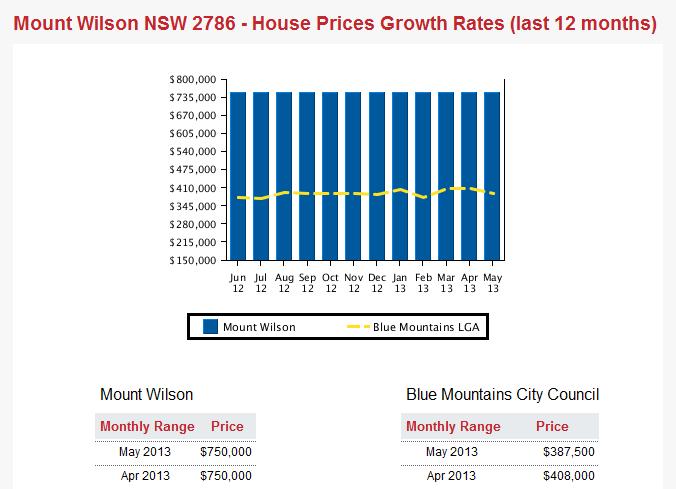
..
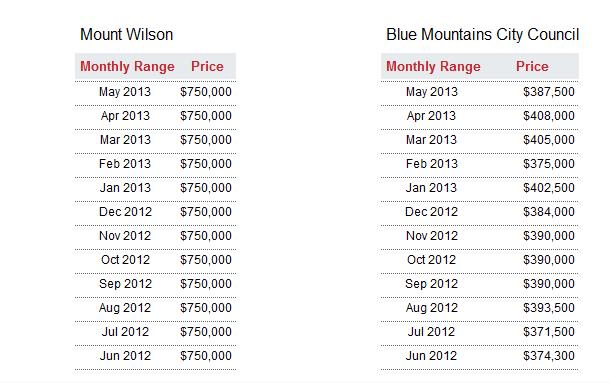 . .
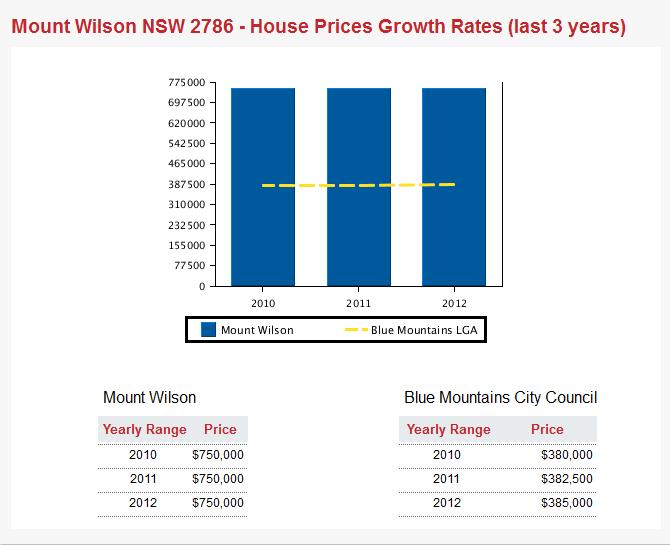 . .
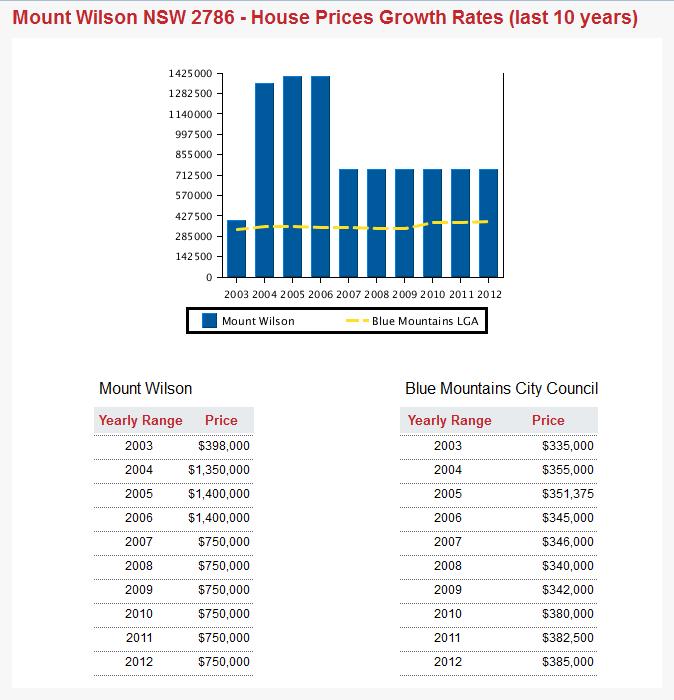 . .
.
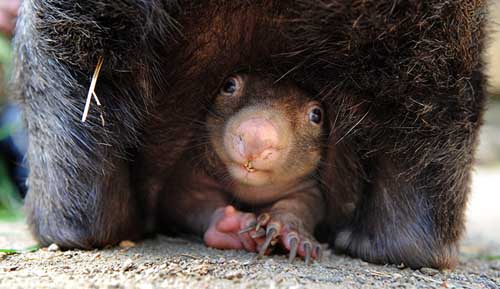
2013 Price?
.
Tags: Anglicising, animal cruelty, Animal Cruelty Syndrome, Animal Harm, Bare-Nosed Wombat, Blue Mountains, Coarse-Haired Wombat, Common Wombat, Living with Wombats, Martin Bryant, Mount Wilson, Mount Wilson Property, Mount Wilson Property Prices, Mount Wilson Real Estate, Mt Wilson, national parks and wildlife act, NSW National Parks and Wildlife Service, sentient, Wombat Gate, Wombat Habitat, wombat poisoned, Wombat Protection
Posted in Blue Mountains (AU), Threats from Development, Threats from Poaching and Poisoning, Wombats | 1 Comment »
Add this post to Del.icio.us - Digg
Sunday, May 26th, 2013
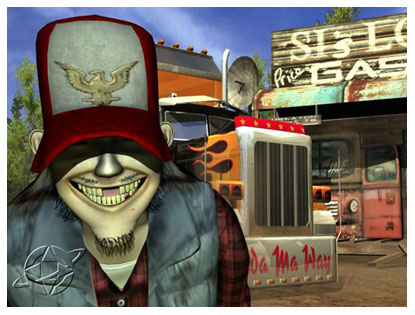 Ada Ma Way! Ada Ma Way!
.
The New South Wales Government’s dictatorial roads department, the RTA-come-RMS, has again kowtowed to the trucking lobby by deciding in its infantile wisdom to remove centre double lines from the Hawkesbury Road through the Blue Mountains west of Sydney, so that big sand trucks with trailers (basically ‘B-Doubles‘) can hog both sides of the highway.
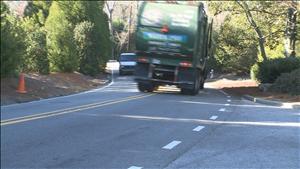 Looka Me Looka Me Looka Me! Looka Me Looka Me Looka Me!
.
The idiots in the fancy new RTA-come-RMA headquarters in Parramatta want no restrictions on truck-length, no speed restrictions for these trucks along Hawkesbury Road – the bigger trucks the better, God Damn!
.
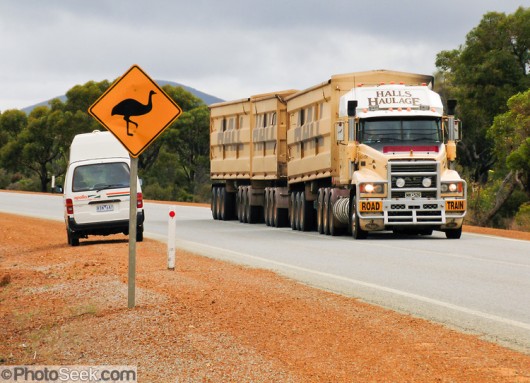 Strategy to avoid a B-Double
An Outback vernacular joke, not so funny… Strategy to avoid a B-Double
An Outback vernacular joke, not so funny…
.
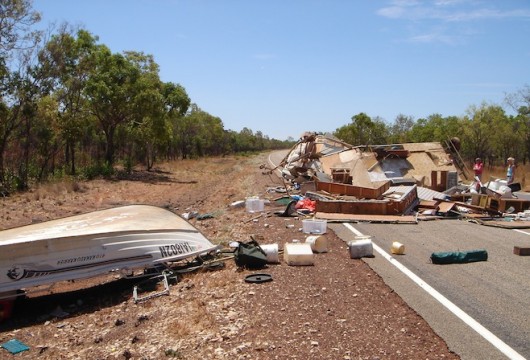 Outback Crash
Often the End of Everyone’s Story! Outback Crash
Often the End of Everyone’s Story!
.
It’s a Northern Territory Outback Approach – unlimited speed and road trains – despite Hawkesbury Road winding tightly down the mountain at Hawkesbury Heights and passing through residential areas between Springwood and Richmond.
.
Winmalee ain’t trucking Tennant Creek!
.
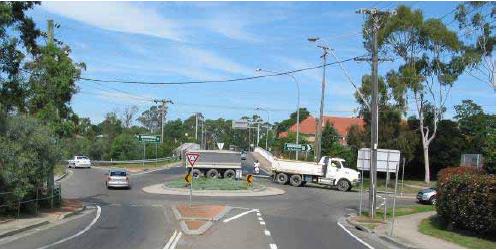 . .
According to Hawkesbury Road residents typically 90 tipper trucks with dog trailers (basically B-Doubles) hoon along the road daily.
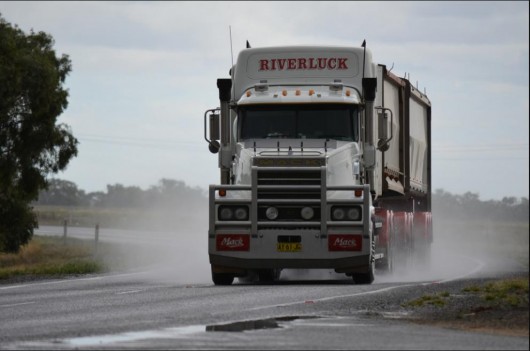 . .
In late 2012, the RTA-come-RMS removed the centre line marking on four hairpin bends at Hawkesbury Heights so that bigger trucks can cross the center of the road without crossing over centre double lines because the double lines have been painted over.
No centre lines, no road centre, see, just like Mount Panorama! No speed cameras, no police patrols, speeding cowboy truckers out of control. Car, motorbike and pedestrian traffic are just collateral damage.
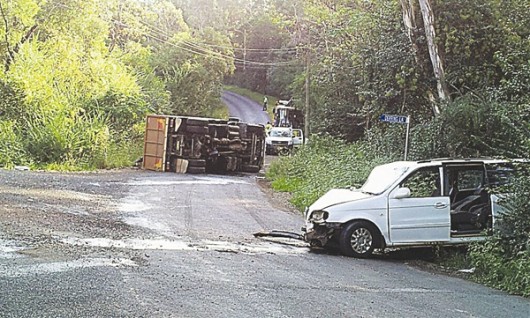 Bugger! Bugger!
Truck rollover along Mill Road at Kurrajong in the Blue Mountains
Cowboy Trucker going too fast – nuh.
[Source: Photo by Top Notch Video, in article ‘Lucky Easter accident escape’, 20120412, by Cerise Burgess, journalist, Hawkesbury Gazette, ^http://www.hawkesburygazette.com.au/story/273890/lucky-easter-accident-escape/]
.
The local Blue Mountains Council has rightly branded the RTA-come-RMS decision to remove these double centre lines as “absolutely insane”‘, “ridiculous” and “plain criminal” at its councillor meeting on 23rd April 23 2013. Councillor Brendan Christie stated, “I just think it is completely ridiculous that six bureaucrats from the RMS sat down for a nice lunch and this is all they could come up with.”
 Blue Mountains Council’s delegated Local Traffic Committee: Minutes of Meeting 20130326 Blue Mountains Council’s delegated Local Traffic Committee: Minutes of Meeting 20130326
.
Two years ago in 2011, the Blue Mountains Council reported on a Road Safety Action Plan. The report identified that:
<<the Blue Mountains has almost triple the amount of speed related crashes than the Sydney Region. Our rate of 33.73% is almost double that of the rate of NSW. This makes reducing speeding on our roads a clear road safety priority for the Blue Mountains community.>>
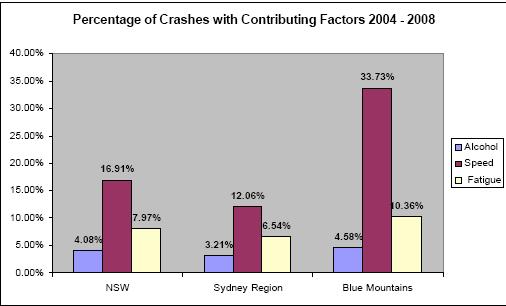 . .
The report also identified trucks as a key issue:
<<The Blue Mountains has a significantly higher proportion of trucks involved in crashes than the Sydney Region, Western Sydney or NSW.
Over a five year period, light trucks constituted 9.53% of crashes in the Blue Mountains. This can be compared with 7.85% in Sydney, 8.31% in Western Sydney and 8.67% in New South Wales as a whole. The Blue Mountains also experienced significant increases in crashes involving trucks over the last five years.>>
.
.
Yet at the same time, the Blue Mountains Council is similarly embracing more trucks transiting through Blue Mountains by planning a new truck route through native bushland habitat and over the headwaters of Fitzgerald Creek and carved through critically endangered Sydney Turpentine Ironbark Forest in protected Deanii Reserve.
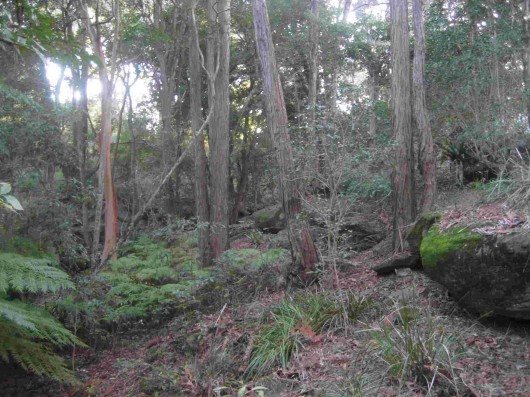 Example of a Sydney Turpentine Ironbark Forest
[Source: ^http://www.georgesriver.org.au/Riverkeeper-Photo-Gallery.html] Example of a Sydney Turpentine Ironbark Forest
[Source: ^http://www.georgesriver.org.au/Riverkeeper-Photo-Gallery.html]
.
The Council has already spent $77,000 on a study to consider possible route options for a truck link road between Hawkesbury Road and the Great Western Highway at Valley Heights. The preferred route necessitates massively increasing the road weight limit, creating a two-lane, three-span bridge 35 metres above Fitzgerald Creek with a total the project construction cost of $26 million, all to encourage more trucks through the Blue Mountains.
Borrowing the same mealy-mouthed spin as the RTA-come-RMS, the Council’s consultants try to justify the new road would “improve traffic flow and reduce delays.” No doubt its environmental impact statement would be conjured up by darkside ecologists to pretend the road works and bridge works would cause minimal impact to endangered ecology.
The initial council study will go on public exhibition soon with a report back to council in August 2013. We shall be ready to rip the EIS apart, or will it be watered down to another Review of Environmental Effects as per usual?
.
[Source: ‘Springwood link road plan’, 20130508, by Shane Desiatnik, journalist, Blue Mountains Gazette, ^http://www.bluemountainsgazette.com.au/story/1486914/routes-named-for-springwood-link-road-plan/]
.
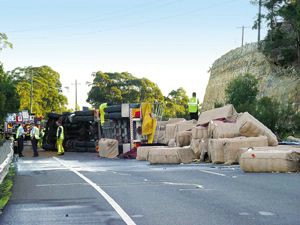 Truck rollover in the Blue Mountains April, 2005
RTA-come-RMS is giving tacit approval for truckers to use excessive speed and ignore common safety measures. Truck rollover in the Blue Mountains April, 2005
RTA-come-RMS is giving tacit approval for truckers to use excessive speed and ignore common safety measures.
.
The RTA-come-RMS is the handmaiden to the truck industry and has allowed Hawkesbury Highway to become a trucking cowboy corridor.
The Bells Line of Road is just a bad:
 . .
Somewhere in the Blue Mountains there is a truck collision or rollover a week. The trucking menace is out of control and these are the bureaucrats responsible – New South Wales Premier Barry O’Farrell and his Roads Minister Duncan Gay.
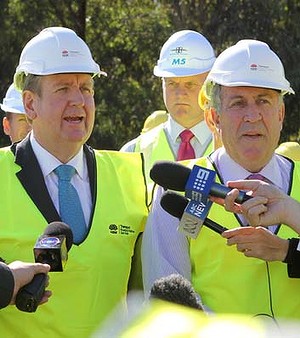 Premier Barry O’Farrell (left) and Roads Minister Duncan Gay
Handmaidens of Trucking Premier Barry O’Farrell (left) and Roads Minister Duncan Gay
Handmaidens of Trucking
.
Local residents and ordinary users of the Hawkesbury Road are intimidated by these trucking cowboys speeding, hogging the road and tailgating like their on a speedway circuit.
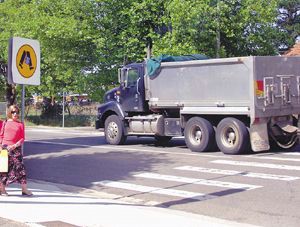 Blackheath, Blue Mountains, already a statistical victim
Betty Dowdell of Blackheath, 16 Dec 2008, rest in peace
Your memory is not lost. Blackheath, Blue Mountains, already a statistical victim
Betty Dowdell of Blackheath, 16 Dec 2008, rest in peace
Your memory is not lost.
.
Drivers on the bends of Hawkesbury Road have raised concerns about the serious risks of heavy vehicles crossing to the wrong side of the road as they negotiate the narrow corners. The Roads and Maritime Service removed the centre lines on the bends late last year which residents say has only increased the problem.
 Trucker Wet Dreaming Trucker Wet Dreaming
.
With four schools on the 10km road, driver safety is paramount both on the Winmalee stretch and also for those people driving down from the Mountains via the bends. According to local politicians, the solution would be for a proper review of the road by the RTA-come-RMS, with a view to enforcing the road rules, including a return to the centre lane markings on the bends and looking at other engineering options.
But many local residents have had enough and are demanding a complete ban trucks from driving on Hawkesbury Road which would mean it would no longer be gazetted as a State Route.
.
Barry, unhitch from the greedy Trucking Lobby
Support the safety concerns of Residents
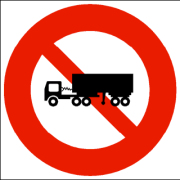 No Articulated Trucks on Hawkesbury Road No Articulated Trucks on Hawkesbury Road
No Trucking Shortcuts!
.
[Source: ‘Hawkesbury Road residents driven round the bend’, 20130424, by Damien Madigan, editor, The Blue Mountains Gazette, ^ http://www.bluemountainsgazette.com.au/story/1454002/hawkesbury-road-residents-driven-round-the-bend/]
.
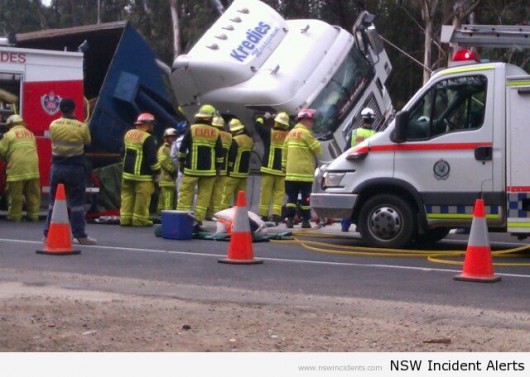 Kredies Trucking speeding down Victoria Pass, 5th December 2011 Kredies Trucking speeding down Victoria Pass, 5th December 2011
.
<<A truck driver has been airlifted to hospital with suspected spinal injuries, and a major cleanup operation has been undertaken following a truck overturning on Mount Victoria Pass this afternoon (5 December 2011).
Emergency Services were called to the bottom of Mount Victoria Pass (Great Western Highway) just after 2:30pm today following reports an eastbound semi-trailer carrying scrap metal had rolled onto the concrete divider, leaving the driver trapped in the cabin.
Several Fire and Rescue NSW crews, Police Rescue, an Ambulance and a rescue helicopter responded to the scene. Rescue crews freed the driver about 4:45pm before he was airlifted to hospital suffering suspected spinal injuries.
The Great Western Highway has been closed for several hours while a clean up and salvage operation is underway with debris scattered across the roadway. The RTA has advised traffic is being diverted into the Darling Causeway with eastbound motorists being advised to use Chifley Road (Mort St) and the Darling Causeway as an alternative route.>>
.
[Source: ‘Truck Overturns at Mount Victoria’, 20111205, by NSW Incident Alerts, ^http://news.nswincidents.com/2011/12/05/traffic/persons-trapped/truck-overturns-mount-victoria/]
.
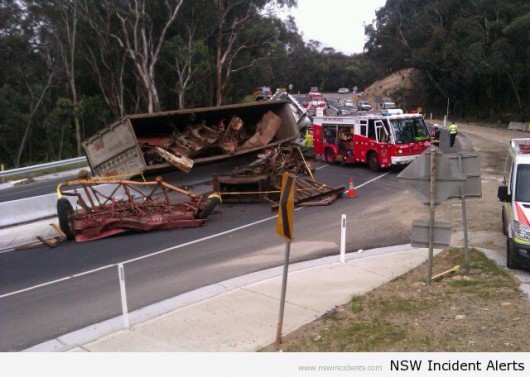 Speeding Truck Overturns down Mt Victoria Pass, 3rd August 2011
Two truckers dead
The pass has been there and steep for a long time – nothing new. Speeding Truck Overturns down Mt Victoria Pass, 3rd August 2011
Two truckers dead
The pass has been there and steep for a long time – nothing new.
.
<<Two men have been crushed to death inside the cabin of a truck in the Blue Mountains today. Police said the truck rolled and crashed into a barrier on the Great Western Highway, near the top of Victoria Pass, just after 10am. The two men were found dead inside the cabin. Their ages are unknown. One eastbound lane of the highway is expected to be closed for some time while police investigate.>>
.
[Source: ‘Two killed in Blue Mountains truck crash’, 20110803, by Georgina Robinson, Sydney Morning Herald, ^http://www.smh.com.au/nsw/two-killed-in-blue-mountains-truck-crash-20110803-1iaqu.html]
.
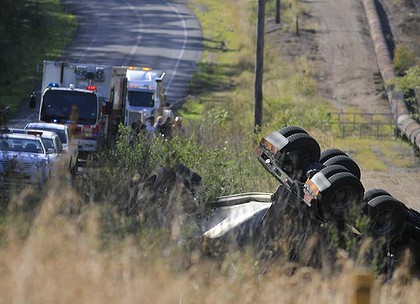 It’s like the approach to Bagdad after Allied Forces’ Battle of Bagdad in 2003 It’s like the approach to Bagdad after Allied Forces’ Battle of Bagdad in 2003
[Source: ‘F3 accident outpost clears way for network of depots’, 20111027, Sydney Morning Herald,
^http://smh.drive.com.au/roads-and-traffic/f3-accident-outpost-clears-way-for-network-of-depots-20111026-1mk7i.html]
.
Footnote
.
Again, we didn’t have to wait long to learn about yet another dangerous trucking cowboy in New South Wales.
In Sydney’s outer north this morning, a truck side-swiped a school bus and didn’t stop.
The small school bus was travelling along Bay Road at 9 am at Berrilee, when the bus driver was forced to swerve to avoid a head-on collision with the truck over the centre lines.
In avoiding the collision, the bus driver scraped along a rockface alongside the left hand side of the narrow section of Bay Road. Four bus windows were smashed, and seven children on the bus suffered minor cuts from the smashed glass. Two of them were taken to hospital. The truck driver drove on (another hit and run) following the incident and yet police decided not to contemplate pursuing criminal charges.
Unbelievably the police are sight unseen self-excusing the trucker for ‘perhaps’ not realising the damage, because of some fabricated personal presumption that the truck was too big for the driver to notice. “We don’t think he even realised something had gone wrong” the police spokesman said.
Was this comment correctly reported by the media? If so, how does the police spokesman know? Does it take a child to die for these police to treat seriously the near fatality of children on a supposedly safe school bus?
If so, these police should state this presumption to the faces of the children’s parents and see what response they get for excusing dangerous trucking behaviour endangering the lives of their children.
If so, then these police are ignorant of what could have happened, of the likely trauma experienced by both bus driver and the children who will never forget this incident that could have ended their lives. These police seem to nonchalantly care nothing for road safety or for proactive policing.
‘She’ll be right reckless trucking‘ is unacceptable and here we record yet another trucking cowboy excused by police, until next time when an innocent road user is killed.
Not good enough!
.
[Sources: ‘Children injured in school bus crash at Berrilee in Sydney’, 20130529, ABC News, ^http://www.abc.net.au/news/2013-05-29/three-children-injured-in-school-bus-crash/4719814?§ion=news; and ‘Sydney school bus crash injures children, 20130529, by AAP, ^http://www.news.com.au/breaking-news/national/children-hurt-in-sydney-bus-crash/story-e6frfku9-1226652814870]
.
 2005: Another B-Double truck slammed into the rear of a school bus while speeding in fog at 8:30 am (school transit time) in country Victoria. About 20 primary school children were lucky not be killed as the back of a school bus was ripped off in the collision near Ballarat.
[Source: Photo by Craig Sillitoe, in article: ‘Bus crash students lucky to be alive’, 20050513, by Adam Morton, The Age, Victoria,
^http://www.theage.com.au/news/National/Bus-crash-students-lucky-to-be-alive/2005/05/13/1115843345721.html]
2005: Another B-Double truck slammed into the rear of a school bus while speeding in fog at 8:30 am (school transit time) in country Victoria. About 20 primary school children were lucky not be killed as the back of a school bus was ripped off in the collision near Ballarat.
[Source: Photo by Craig Sillitoe, in article: ‘Bus crash students lucky to be alive’, 20050513, by Adam Morton, The Age, Victoria,
^http://www.theage.com.au/news/National/Bus-crash-students-lucky-to-be-alive/2005/05/13/1115843345721.html]
.
Tags: Ada Ma Way, Barry O'Farrell, Bay Road, Berrilee, Blue Mountains, Blue Mountains Council, centre double lines, cowboy truckers, Duncan Gay, Hawkesbury Heights, Hawkesbury Road, Mill Road, Road Safety Action Plan, RTA-come-RMS, sand trucks with trailers, school bus, Springwood, State Route, Sydney Turpentine Ironbark Forest, tipper trucks with dog trailers, truck crash, trucking expressway, Winmalee
Posted in Blue Mountains (AU), Threats from Road Making | No Comments »
Add this post to Del.icio.us - Digg
Wednesday, May 22nd, 2013
Blue Mountains communities are rightly frightened of these killer B-Double cowboys hurtling along the Great Western Highway
.
~ the more lanes, the faster they hurtle!
.
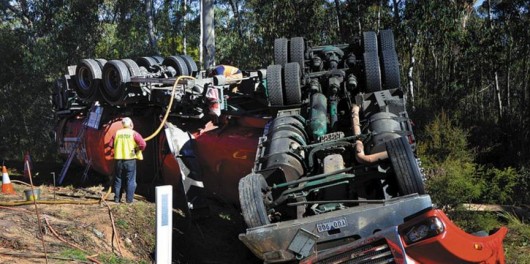 Last week: B-Double fuel truck driver fell asleep at the wheel through Medlow Bath
This Ron Finemore’s driver fell asleep at the wheel of this dangerous B-Double fully laden with petrol, while hurtling through Medlow Bath.
[Source: Photo by Len Ashworth, Lithgow Mercury, 20130512,
^http://www.bluemountainsgazette.com.au/story/1500162/lucky-escape-for-truck-driver/?cs=12]
.
His job is currently advertised: ^http://www.ronfinemoretransport.com.au/career-opportunities [>Read More.pdf ] Last week: B-Double fuel truck driver fell asleep at the wheel through Medlow Bath
This Ron Finemore’s driver fell asleep at the wheel of this dangerous B-Double fully laden with petrol, while hurtling through Medlow Bath.
[Source: Photo by Len Ashworth, Lithgow Mercury, 20130512,
^http://www.bluemountainsgazette.com.au/story/1500162/lucky-escape-for-truck-driver/?cs=12]
.
His job is currently advertised: ^http://www.ronfinemoretransport.com.au/career-opportunities [>Read More.pdf ]
.
May 2013: B-Double Driver Falls Asleep
.
<<A fully-laden double fuel tanker overturned in a short, straight, three-laned section of the highway between Katoomba and Medlow Bath in the early hours of Sunday, May 12.
The giant rig owned by Orange-based Ron Finemores Transport was being driven west when it veered onto the road shoulder and overturned down an embankment, coming to rest with the twin tankers upside down.
An ambulance spokesman said the driver, a 34-year-old Millthorpe man, was able to free himself from his wrecked cabin and clambered back to the roadway where one of the first on the scene was an off-duty paramedic. He was taken to Katoomba Hospital and treated for minor facial injuries.
Driver Fatigue is suspected as a possible cause of the smash.>>
.
[Source: ‘Lucky escape for truck driver’, 20130515, by Len Ashworth, editor The Lithgow Mercury newspaper, ^http://www.bluemountainsgazette.com.au/story/1500162/lucky-escape-for-truck-driver/?cs=12]
.
[Ed: So are Finemore’s drivers paid by the hour or by completed trip – where the more trips and the faster they hurtle along, the cheaper it is for the trucking corporation? Are there any unions left to represent truck drivers’ occupational health and safety on The Road as a Workplace?
.
On The Road as a Workplace, the New South Wales Government provides no truck rest stop along the entire length of the Great Western Highway between Orange and Sydney (255 km) in either direction to properly cater for heavy vehicle driver fatigue.
.
The token parking bay at Faulconbridge westbound through the Blue Mountains is a substandard joke, with the only facilities being two rubbish bins. The westbound shoulder at Mount Victoria opposite the Caltex Service Station for trucker cabin sleeping is a disgraceful defacto emergency stopover and only inflicts noise pollution to nearby locals 24/7.
.
Overpaid NSW Transport urban bureaucrats Peter Duncan, Les Wielinga, Roads Minister Duncan Gay, and millionnaire magnate Ron Finemore need to do a few nights truck cabin kip there (this time of year) and then directly turn up for work the next day. At the same time, these same NSW Government urban bureaucrats justify billions to widen the highway to four lanes to facilitate more corporate truck freight – as if an urban fatigue free route.
.
Ron Finemore Transport is one of the corporate trucking lobbyists pushing for more and bigger trucks along the Great Western Highway. In 2012 the company opened a new $9 million facility in Orange along the highway to house its 120 B-Double truck drivers and fleet of 50 B-Doubles.
.
Selfish trucking magnates like Finemore divert New South Wales Government from investing in freight rail services and infrastructure. They perpetuate the dangerous B-Double Menace that is increasingly killing and maiming ordinary users of our regional highways and a deadly social problem avoided by governments around Australia.]
.
[Source: ‘Finemore opens $9 million facility in regional NSW’, 20121012, ^http://ichainnel.com/en/news/361889_0ikxd5.html]
.
May 2013: Truck kills a Woman in her Car
.
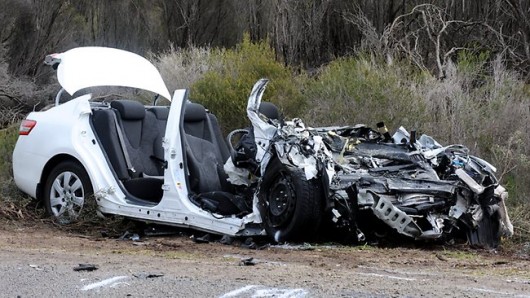 Different head-on collision, but similar consequence
[Source: Photo by Richard Polden, Perth Now
^http://www.perthnow.com.au/news/western-australia/motorist-trapped-after-car-truck-head-on-in-bullsbrook/story-e6frg13u-1226111010848] Different head-on collision, but similar consequence
[Source: Photo by Richard Polden, Perth Now
^http://www.perthnow.com.au/news/western-australia/motorist-trapped-after-car-truck-head-on-in-bullsbrook/story-e6frg13u-1226111010848]
.
<<A woman has died after a crash between a truck and car today (Thursday) at Luddenham in Sydney’s west, police say. Police and other emergency services attended the collision on The Northern Road, near Littlefields Rd, about 10am. A brief will be prepared for the Coroner.
.
Meanwhile, a 44-year-old man has been injured after a multiple-vehicle crash in Sydney’s west this morning. About 5:05am, two semi-trailers, A Toyota Hilux utility and a Ford sedan at the intersection of the Great Western Highway and Doonside Rd at Arndell Park. Emergency services personnel took about 30 minutes to remove the utility driver from the vehicle. He is being treated in Westmead Hospital for chest and arm injuries.>>
.
[Source: ‘Woman dies in crash involving truck’, 20130515, Cowra Community News, ^http://cowracommunitynews.com/viewnews.php?newsid=3650&id=4]
.
May 2013: Truck Drivers do Hit and Run
.
<<A B-Double truck travelling in lane three on the M4 Motorway near St Clair (Sydney’s west) has changed lanes and moved into the path of a utility this morning (Sunday).
The B-Double struck the car and the car then flipped over and ended on its roof, killing the car driver. The driver of the B-Double truck failed to stop and continued travelling west along the M4.
[Ed: … I own the road but I saw nuuthing!]
.
<<Meanwhile, a 32-year-old male pedestrian has suffered a serious leg fracture when he was struck by a truck in another hit-and-run near Newcastle last night (Saturday).
Police say the man was walking north in the breakdown lane of the Pacific Highway at Tomago, where three lanes merge into two, when he was hit by a truck at a point past the northern end of Hexham Bridge about 6:45pm. The man was thrown on to the highway’s grass shoulder, while the truck did not stop!
The injured man managed to crawl back to the edge of the road and hail a passing motorist for help, police say. He was treated at the scene and taken to Newcastle’s John Hunter Hospital suffering a serious lower leg fracture. The Newcastle Crash Investigation Unit is looking into the crash and making attempts to track down the truck involved.>>
[Ed: … I own the road but I saw nuuthing!]
.
May 2013: B-Double hangs off Melbourne’s Bolte Bridge
.
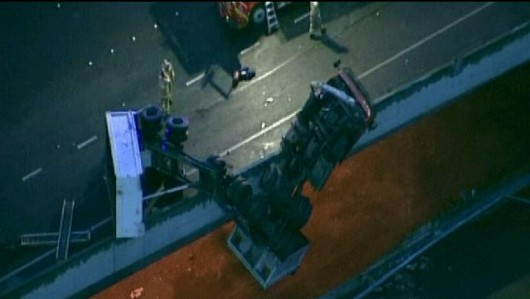 B-Doubles Out of Control B-Doubles Out of Control
.
<<The driver plunged from the cabin of his vehicle after a road crash left the truck’s cabin dangling off Melbourne’s Bolte Bridge just after 6.30am today (17th May, 2013).
There is traffic chaos on a Melbourne freeway where a truck has crashed and been left dangling precariously over the side. The truck driver was taken to Royal Melbourne Hospital and is in a critical condition. The driver of the other car was also taken to hospital in an unknown condition.
The incident has caused chaos on the Tullamarine Freeway, which is now closed to inbound traffic at Flemington Road. City-bound traffic on the Tullamarine Freeway remains at a standstill.
The road will likely be closed until later today and transport authority VicRoads has advised motorists to avoid the heavily-congested area. Crews will work to remove the truck, which is hanging halfway over the bridge, and assess damage to the road before it is reopened to motorists.>>
.
[Source: ‘Man falls from truck dangling off bridge’, 20130517, by Sylvia Varnham O’Regan, Nine News (TV), ^http://news.ninemsn.com.au/national/2013/05/17/07/16/truck-hanging-from-bridge-after-freeway-crash]
.
May 2013: Woman dies in crash involving truck
.
<<A woman has died after a crash between a truck and car today (Thursday) at Luddenham in Sydney’s west, police say. Police and other emergency services attended the collision on The Northern Road, near Littlefields Rd, about 10am. A brief will be prepared for the Coroner.
.
Meanwhile, a 44-year-old man has been injured after a multiple-vehicle crash in Sydney’s west this morning.
About 5:05am, two semi-trailers, A Toyota Hilux utility and a Ford sedan at the intersection of the Great Western Highway and Doonside Rd at Arndell Park.
Emergency services personnel took about 30 minutes to remove the utility driver from the vehicle. He is being treated in Westmead Hospital for chest and arm injuries. No one else was injured, police say.>>
.
[Source: ‘Woman dies in crash involving truck’, 20130515, Cowra News, NSW, ^http://cowracommunitynews.com/viewnews.php?newsid=3650&id=4]
.
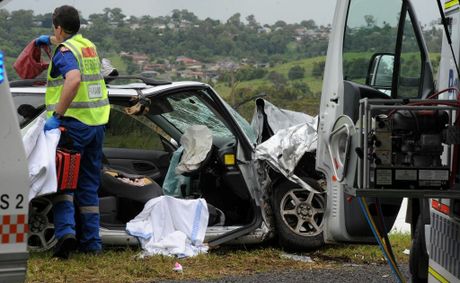 Dec 2010: Ballina, NSW – a multiple vehicle crash caused by a truck over the centre line
[Source: ^http://www.northernstar.com.au/news/trucks-crash-bangalow-road/712289/]
Dec 2010: Ballina, NSW – a multiple vehicle crash caused by a truck over the centre line
[Source: ^http://www.northernstar.com.au/news/trucks-crash-bangalow-road/712289/]
.
Apr 2013: Truck catches Fire
.
<<A truck driver had a lucky escape after his semi-trailer caught fire in Victoria’s north. The truck carrying carpet was travelling on the Hume Highway near Wallan when the blaze began at 2pm. It is understood the driver fled the cabin of the truck as soon as he noticed the flames.
Up to 13 fire crews have been on scene battling the big blaze for hours. Police will investigate the cause of the fire as soon as it has been brought under control.
.
[Source: ‘Truck fire causes Hume Highway delays near Wallan’, 20130421, by Alex White, Herald Sun (Victoria), ^http://www.heraldsun.com.au/news/victoria/truck-fire-causes-hume-highway-delays-near-wallan/story-e6frf7kx-1226625363194]
.
Apr 2013: Plastics truck explodes on highway
.
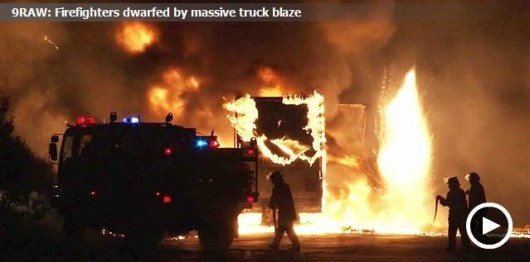 Truck explodes on Hume Freeway near Berrima Truck explodes on Hume Freeway near Berrima
.
<<A driver escaped injury after a truck loaded with plastics exploded on a highway south-west of Sydney early this morning.
A truck loaded with wheelie bins has been engulfed in fire on a highway south-west of Sydney. The truck caught fire just (around midnight) today on the Hume Highway, south of Berrima.
A spokesperson for the NSW Rural Fire Service told ninemsn the trailer was filled with 800 domestic garbage bins. Molten plastic spread across the southbound lanes of the highway.
It took six fire trucks to extinguish the blaze which caused “extensive” damage to the trailer.>>
.
[Source: ‘Plastics truck explodes on highway’, 20130501, by Sophie Cousins, Nine News (TV), ^http://news.ninemsn.com.au/national/2013/05/01/08/17/plastics-truck-explodes-on-highway]
.
Apr 2013: Young man killed in horror head-on with B-Double
.
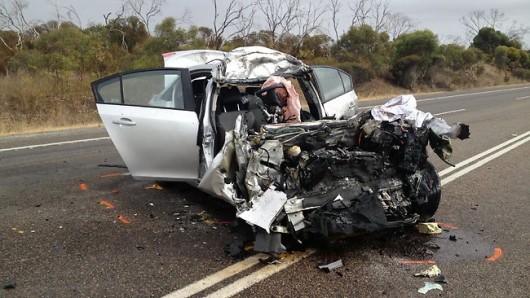 Nothing Left Nothing Left
Pacific Highway near Ulmarra
.
<<Police confirmed a man aged in his 20s died after the southbound Mazda 929 he was driving was involved in a head-on with a B-Double truck. The crash happened 3km north of the town about 3.15am.
Witnesses told police after the initial impact the truck swerved off the highway, rolled onto its side into a paddock and burst into flames. Firefighters who battled the blaze said the driver had a lucky escape. Fire crews said they were met by an inferno when they arrived on scene with flames rising as high as 10 to 20 metres above the wreckage.
The accident happened on a notorious Pacific Highway section…>>
.
[Source: ‘Young man killed in horror head-on with b-double’, 20130423, Coffs Coast Advocate newspaper, ^http://www.coffscoastadvocate.com.au/news/horror-head-on-crash-kills-man/1841067/]
.
Apr 2013: Speeding B-Double crashes and cattle killed, others shot
.
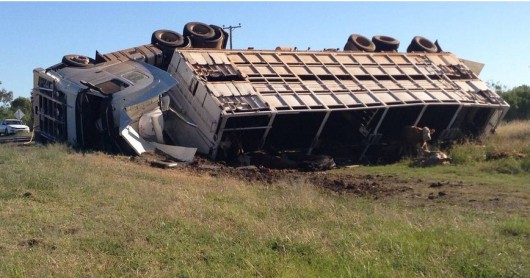 B-Double Cattle Truck crash kills livestock, injured cattle are shot
Photo by Moree Champion B-Double Cattle Truck crash kills livestock, injured cattle are shot
Photo by Moree Champion
<<There was yet another truck roll on the Garah/Mungindi Road.
Dozens of cattle have been killed in a B-Double accident in north-west NSW. The truck rolled on a bend on the outskirts of Garah near Moree just after seven this morning.
Moree Plains Council ranger Jock Jones says locals are working together to save what cattle they can, and round up those that got away.
“We’ve used grinders to open the tray up. We’ve got a front end loader that’s pulling the truck apart,” he said. “It’s a hideous job now. Pulling them out is very sad. I’ve had to shoot a lot but we are saving a lot. “Most of them have got out and run off.”
There were about 60 cattle on board. It’s thought the cattle had come from Longreach in Queensland.
The 46-year-old driver of the truck was thrown clear on impact. He was treated by paramedics for facial injuries and cuts to his arms, back and legs. He was taken to Moree hospital in a stable condition.>>
.
Ed: Previously on the same stretch of road: ‘Sheep killed in truck rollover near Garah’, 22nd February 2010…<<Dozens of sheep died and others were put down after a B-Double truck rolled over near Garah yesterday (Sunday).>>
.
[Sources: ‘Cattle euthanased after B-double crash’, 20130408, Northern Daily Leadernewspaper, ^http://www.northerndailyleader.com.au/story/1417892/cattle-euthanased-after-b-double-crash/, and ‘Truck crash kills dozens of cattle’, 20130408, by Lisa Herbert, ABC Rural, ^http://www.abc.net.au/rural/news/content/201304/s3732059.htm]
.
Mar 2013: Two Escape Sydney Truck Fire
.
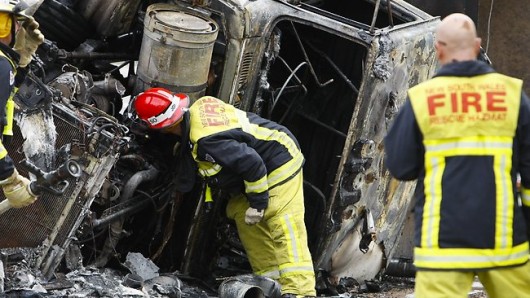 Truck Crash at the corner of Roger St and Old Pittwater Rd Brookvale, on Sydney’s Northern Beaches
[Photo by Cameron Mitch, The Sunday Telegraph] Truck Crash at the corner of Roger St and Old Pittwater Rd Brookvale, on Sydney’s Northern Beaches
[Photo by Cameron Mitch, The Sunday Telegraph]
.
<<Two people have escaped with minor injuries after the truck they were travelling in rolled over and caught on fire in Sydney’s north. The semi-trailer truck, which was carrying sand, rolled over about 8am on Old Pittwater Road in Brookvale, Fire and Rescue NSW said on Saturday.
“Two people escaped from the truck’s cabin before it caught fire,” Superintendent Tom Cooper told AAP. “The fire caused one of the truck’s 400 litre tanks of diesel to rupture and the diesel spilled into a storm water drain.”
.
[Source: ‘Two escape north Sydney truck fire’, 20130309, by AAP, Daily Telegraph newspaper, ^http://www.dailytelegraph.com.au/two-escape-north-sydney-truck-fire/story-e6freuy9-1226593712677]
.
Mar 2013: Two killed after B-Double and car collide head-on
.
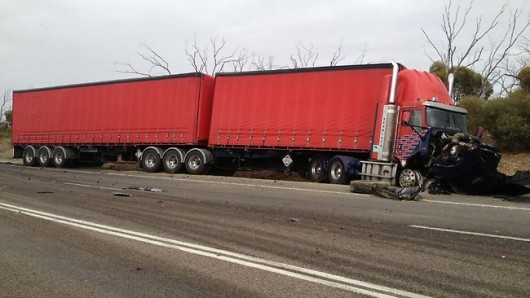 No chance at Ki Ki, South Australia No chance at Ki Ki, South Australia
Picture: First On Scene Media Source: adelaidenow
.
<<..In a shocking start to the Easter holidays, two people, both aged 22, believed to be Asian nationals living in Adelaide, died after the rental car they were driving crossed to the wrong side of the road and slammed into a B-Double truck on the Dukes Highway near Ki Ki (South Australia), just before 3am.
..Royal Automobile Association public affairs general manager Penny Gale said this stretch of highway accounted for a third of all the state’s road fatalities.
..Major Crash Investigation Section officer-in-charge Detective Inspector Peter Duance said it was a “tragedy” and he warned of the dangers of fatigue when driving in the early hours of the morning. “Sometimes, it’s a good idea to travel in the early hours because there is less traffic on the road but people need to remember to take appropriate rest breaks and share the driving if possible,” he said yesterday.
The deaths take the state’s road toll to 31 compared with 25 this time last year.
.
[Source: ‘Two killed after B-double and car collide head-on along Dukes Highway’, 20130329, by David Nankervis, The Advertiser newspaper, ^http://www.adelaidenow.com.au/news/south-australia/two-killed-after-b-double-and-car-collide-head-on-along-dukes-highway/story-e6frea83-1226608881287]
.
Mar 2013: B-Double carrying fertiliser rollover near Hummocks, SA
.
<<Nobody was injured when a B-Double carrying fertiliser rolled onto its side on the Copper Coast Highway last Tuesday, March 19. Police were called to the accident about 2pm and put traffic restrictions in place which lasted until the scene was cleared six hours later. The crash happened just south of the Hummocks.
.
[Source: ‘Police News… B-double rollover near Hummocks’, 20130326, Yorke Peninsula Country Times, South Australia, ^http://www.ypct.com.au/index.php/news/91-news2/1705-police-news-b-double-rollover-near-hummocks]
.
Mar 2013: “wobbling trailer” or Speed causes B-Double Rollover?
.
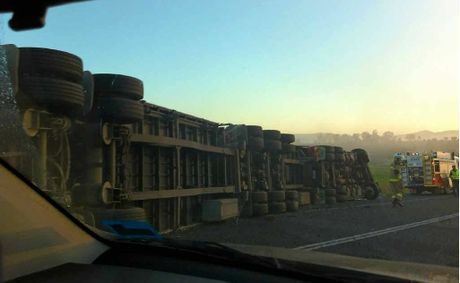 B-Double rollover on the Cunningham Hwy at Maryvale B-Double rollover on the Cunningham Hwy at Maryvale
.
<<The B-Double rollover on the Cunningham Hwy at Maryvale (north east of Warwick, south-eastern Queensland) on Saturday morning. One lane of the Cunningham Hwy was blocked at Maryvale from 6am Saturday until mid-afternoon after a B-Double rolled over. The truck was carrying general freight, including small motors and bags of grain.
A Warwick police spokesman said it was believed the rear trailer started to wobble which resulted in the whole vehicle turning over on one lane of the highway…Police said there was extensive damage to the prime mover.
There was also a single vehicle rollover at Pyramid’s Rd, Stanthorpe, at 12.45pm Saturday. No one was injured.
.
[Source: ‘B-double Rollover causes highway traffic delays’, 20130318, ^http://www.warwickdailynews.com.au/news/b-double-rollover-causes-highway-traffic-delays/1795182/]
.
Feb 2013: Truck fire in Sydney Harbour Tunnel
.
<<Motorists are experiencing extensive peak hour delays following a truck fire in the Sydney Harbour Tunnel. The fire started in the truck’s battery compartment, but the cause is still to be determined.
Traffic is banked up at both ends of the tunnel after a freightliner in the southbound lane caught on fire just after 4pm on Wednesday, activating a fire alarm and causing the closure of the tunnel.
A Transport Management Centre spokeswoman says motorists in the area are being diverted onto the Sydney Harbour Bridge, but there are extensive delays for northbound and southbound traffic. Emergency services are on site, and there is no forecast for when the tunnel will reopen.>>
.
[Source: ‘Truck fire closes Sydney Harbour Tunnel’, 20130220, by AAP, ^http://www.news.com.au/breaking-news/national/truck-fire-closes-sydney-harbour-tunnel/story-e6frfku9-1226582150849]
.
Oct 2012: Multiple truck crash on Sydney’s M4
.
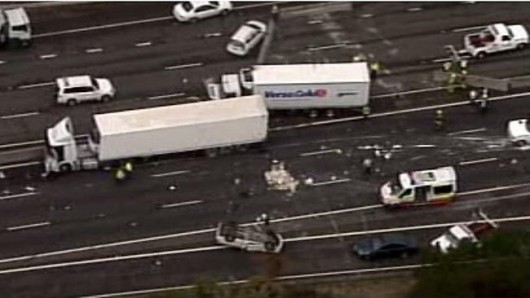 A crash on the M4 freeway closed both lanes of traffic
[Source: Picture by Gregg Porteous, The Daily Telegraph] A crash on the M4 freeway closed both lanes of traffic
[Source: Picture by Gregg Porteous, The Daily Telegraph]
.
<<A multi-vehicle pile up on the M4 has closed the motorway in both directions. At least five vehicles, including two trucks collided near the intersection with Silverwater Rd about 1.15pm. …The accident left one ute on its roof, while two trucks hit the concrete median barrier pushing sections into the path of oncoming traffic.
Meanwhile, Sydney’s traffic woes have worsened with a broken down truck closing down the westbound tunnel of the M5 East. The tunnel was shut shortly after 2pm, with tow trucks enroute to clear the vehicle. But to make matters worse the usual detour route around the tunnel is also shut in both directions after a truck brought down powerlines on Stoney Creek Rd near the intersection of Mimosa St, Bexley.
.
[Source: ‘Major accident on M4 near Silverwater Road causes traffic delays’, 20121011, by Henry Budd, The Daily Telegraph newspaper, ^http://www.dailytelegraph.com.au/news/nsw/major-accident-on-m4-near-silverwater-road-causes-traffic-delays/story-fnb5f12x-1226493579913]
.
April 2012: Truck on Fire on Hume Highway
.
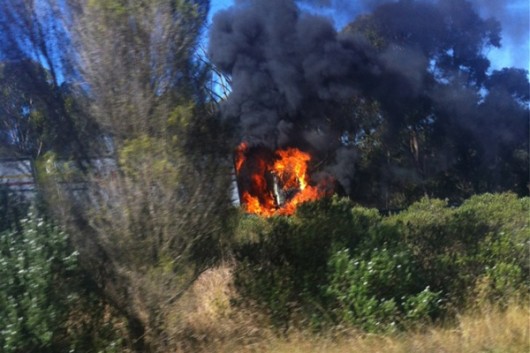 Truck on Fire on Hume Highway, near Yerrinbool Truck on Fire on Hume Highway, near Yerrinbool
Photo by Petrina Price
.
<<There are major delays for motorists on the Hume Hwy near Yerrinbool after a truck burst into flames this morning… just after 9.40am near Remembrance Drive.One of two southbound lanes is closed and traffic is queued for about 4.5km. Motorists are advised to avoid the area if possible.>>
.
[Source: ‘Yerrinbool: Hume Hwy delays after truck fire’, 20120412, Illawarra Mercury newspaper, ^http://www.illawarramercury.com.au/story/112596/yerrinbool-hume-hwy-delays-after-truck-fire/]
.
Dec 2011: Rollover of B-Double carting wool
.
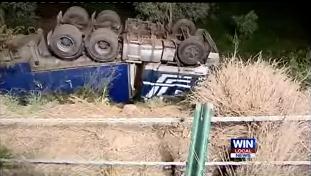 B-Double Rolled on Ballimore Highway near Dubbo B-Double Rolled on Ballimore Highway near Dubbo
.
<<There was a B-Double truck rollover east of Ballimore on the Golden Highway. The truck was carrying a full load of wool.>>
.
[Source: ‘Ballimore B-Double rollover’, 20111210, Win News, ^http://www.orana.rfs.nsw.gov.au/file_system/attachments/Orana/Attachment_20111210_6B7E3C94.wmv]
Sep 2010: Truck collision closes Hume Highway
.
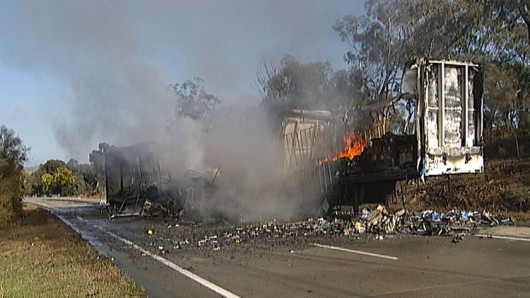 Fire erupted in the trailers of the two trucks after they crashed on the Hume Highway near Yass
[Photo by ABC News] Fire erupted in the trailers of the two trucks after they crashed on the Hume Highway near Yass
[Photo by ABC News]
.
<<Northbound lanes of the Hume Highway north of Canberra remain closed after a fiery crash between two trucks. Fire erupted in the trailers of the vehicles after they collided about 10 kilometres from Yass just after 4:00am.
One of the truck drivers aged in his 50s suffered minor injuries and was taken to hospital. Firefighters had difficulty extinguishing a blaze in the paper cargo of one of the trucks.>>
.
[Source: ‘Truck collision closes Hume Highway’, 20100924, ABC News, ^http://www.abc.net.au/news/stories/2010/09/24/3020651.htm?site=canberra]
.
Mar 2009: B-Double drags pedestrian 100 metres in hit-run
.
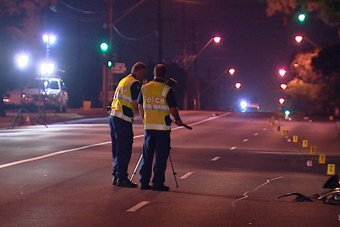 Police gather evidence after a pedestrian was killed in a hit-run in Reservoir (Melbourne) Police gather evidence after a pedestrian was killed in a hit-run in Reservoir (Melbourne)
.
<<Police say a female pedestrian was dragged 100 metres down the road in a fatal hit-and-run at Reservoir, in Melbourne’s north.
Police are questioning a 45-year-old man about the woman’s death, at the intersection of High Street and Broadhurst Avenue, about 10:30pm yesterday. The man was arrested at Epping early this morning.
Police say the B-Double prime mover and trailer stopped briefly after the collision, then took off. Sergeant Brendan Butland says the woman died at the scene.
“What’s occurred is tragic,” he said. “A lady was obviously standing on the street corner when the truck’s turned left. She’s been struck by the truck and has been dragged a hundred metres or so down the road, and it’s just tragic.”
The B-Double is now under police guard.>>
.
[Source: ‘B-double drags pedestrian 100 metres in hit-run’, 20090311, ^http://www.abc.net.au/news/2009-03-11/b-double-drags-pedestrian-100-metres-in-hit-run/1614926]
.
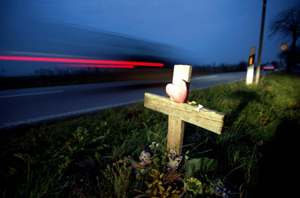 . .
Further Reading:
.
.
.
.
Footnote
.
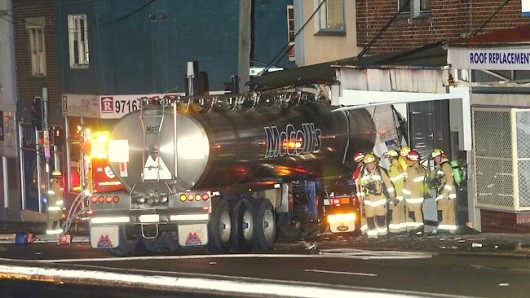 McColl’s Milk Tanker slams at speed into a Parramatta Road cafe on the corner of Croydon Road, Croydon McColl’s Milk Tanker slams at speed into a Parramatta Road cafe on the corner of Croydon Road, Croydon
.
We didn’t have to wait long. Close to midnight last night, an out-of-control fully-laden milk tanker heading into Sydney along Parramatta Road, crossed over the centre concrete medium stip and slammed into a cafe, where residents were sleeping above. The prime mover then caught fire as it was wedged inside the cafe.
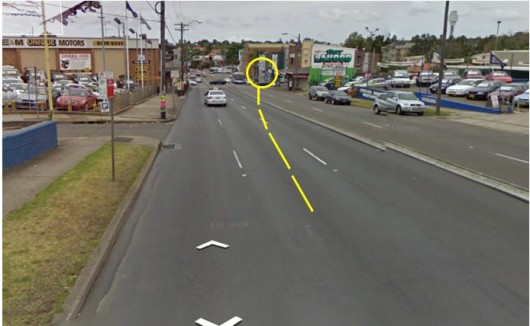 Milk Truck approach on eastbound side of Parramatta Road toward the Croydon Road intersection. Looking east along Parramatta Road toward the Croydon Road cafe (circled)
.
More lanes and more trucks are making our highways more dangerous.
[Image construct via Google Maps, before the crash] Milk Truck approach on eastbound side of Parramatta Road toward the Croydon Road intersection. Looking east along Parramatta Road toward the Croydon Road cafe (circled)
.
More lanes and more trucks are making our highways more dangerous.
[Image construct via Google Maps, before the crash]
.
The driver was probably on a linehaul service from Central West New South Wales delivering a milk load to Parmalat’s manufacturing plant at Lidcombe. The driver died on impact. Did he fall asleep like the Finemore’s driver driving through Medlow Bath around midnight on Sunday 12 May? (see lead post above).
It is yet another serious truck crash along the Great Western Highway corridor involving a trucking company based in Orange. In this case, McColl’s Milk Transport operates out of Orange at 8 Barret Street.
Did the 63 year old driver have a heart attack or stroke? How fit are these truck drivers? How often are they medically tested to operate such killing machines on our highways?
The RTA-come-RMS lets anyone get a truck licence these days. It Heavy Vehicle Competency Based Assessment programme is a joke.
The out of control truck hurtling on the wrong side of a six-laned Parramatta Road could have caused a head-on collision and killed many others, including the owners of the cafe. As it was, the main Sydney arterial Parramatta Road was closed in both directions for hours causing major delays during the busy Friday morning peak.
A year ago, a McColl’s B-Double milk truck collided with a Countrylink bus along on the Gwyder Highway halfway between Grafton and Glen Innes. It was about 3:30 pm, also on a Friday, on 10th February 2012. The Countrylink bus driver was killed and his passengers received minor injuries..
 B-Double McColl’s milk truck over the double lines kills Countrylink bus driver on the Gwyder Highway in February 2012.
[Source: Photo by Debrah Novak, The Daily Examiner, from article ‘Fatal crash on Gwydir’, 20120210, Coffs Coast Advocate, ^http://www.coffscoastadvocate.com.au/news/fatal-bus-and-truck-accident/1267856/] B-Double McColl’s milk truck over the double lines kills Countrylink bus driver on the Gwyder Highway in February 2012.
[Source: Photo by Debrah Novak, The Daily Examiner, from article ‘Fatal crash on Gwydir’, 20120210, Coffs Coast Advocate, ^http://www.coffscoastadvocate.com.au/news/fatal-bus-and-truck-accident/1267856/]
These B-Doubles are too big and too dangerous
.
[Sources: ‘Man dies in Croydon milk truck crash’, 20130524, ^http://www.skynews.com.au/national/article.aspx?id=874647]; and ‘Fatal crash on Gwydir’, 20120210, Coffs Coast Advocate, ^http://www.coffscoastadvocate.com.au/news/fatal-bus-and-truck-accident/1267856/]
.
.
The Trucking Menace is out of control!
.
Tags: B-Double Cattle Truck, B-double crashes, B-Double Menace, b-doubles, B-Doubles Out of Control, Blue Mountains, corporate trucking lobbyist, crash involving truck, dangerous trucks, Driver Fatigue, Great Western Highway, Great Western Highway development, head-on collision, Killer B-Double Cowboys, Orange, RMS, RTA, RTA-come-RMS, Speeding B-Double, The Road as a Workplace, Truck catches Fire, truck crash, truck driver occupational health and safety, truck overturns, trucking expressway
Posted in Blue Mountains (AU), Threats from Road Making | No Comments »
Add this post to Del.icio.us - Digg
Saturday, May 11th, 2013
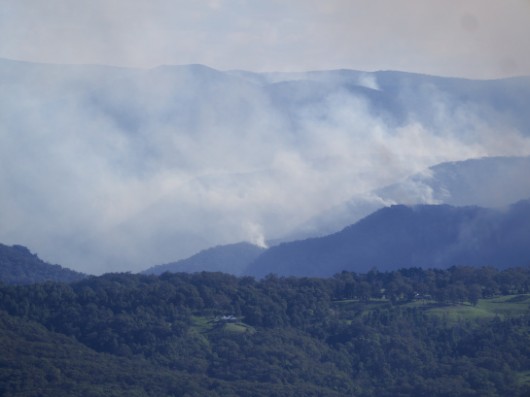 Aerial Arson of Mt Cronje
(A recent example of aerial arson to the Blue Mountains World Heritage) Aerial Arson of Mt Cronje
(A recent example of aerial arson to the Blue Mountains World Heritage)
.
Once again across the Greater Blue Mountains World Heritage Area, smoke blocks out the horizon.
Once again the custodian of the natural values of the World Heritage Area has set fire to it in the middle of wilderness, over 15km from the nearest human habitation.
The New South Wales National Parks and Wildlife Service (NPWS) Regional Manager, a Mr Geoff Luscombe, is proud of his widespread lighting of natural vegetation in as part of the cult of ‘Hazard Reduction‘.
On this occasion some 5,640 heactares of wilderness vegetation in the remote Wild Dog Mountains of the southern Blue Mountains National Park was targeted as a hazard.
This wild wilderness region is wholly within the internationally protected Greater Blue Mountains World Heritage Area. And so we have wolves managing the chickens.
It was a hazard because it hadn’t been burnt for many years, perhaps 20 years, so according to hazard cult orthodoxy, unburnt bushland asked for it and so had to be burnt. No concern for native fauna was made and no concern for fire sensitive flora was made. Such values are condemned as fuel hazards.
.
 The Tigerquoll (Dasyurus maculatus)
A rare and threatened top order predator of the Blue Mountains
The Tigerquoll (Dasyurus maculatus)
A rare and threatened top order predator of the Blue Mountains
.
Like in the Vietnam War, the choppers were called in with aerial incendary to set fire indiscriminately to all wilderness below and to its world heritage values.
.
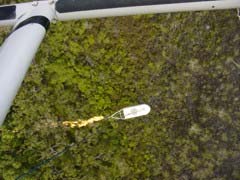 Aerial incendiary dropped from helicopter in National Park wilderness Aerial incendiary dropped from helicopter in National Park wilderness
.
So the NPWS set fire to the vast wilderness area way south of Jamison Valley, way south of Mount Solitary and south of Cedar Valley beyond – between Green Gully, Cox’s River, Narrow Neck and the remote Wild Dog Mountains.
Hazard reduction for whose perverted gratification, and to benefit whom?
And Luscombe boasted that the Wild Dog West burn will be the largest burn undertaken in Blue Mountains National Park for many years.
Once underway, the Wild Dog Mountains burn will affect the following locations:
- Green Gully picnic and camping areas (Dunphy’s Camp) will be closed during and after the operation
- Wild Dog Mountains, the Kanangra to Katoomba track, Splendor Rock, Yellow Dog track, Blue Dog track, Breakfast Creek track, Carlons Head off Narrow Neck Bell Bird Ridge track and the Cox’s River south of Breakfast Creek
.
Since 1st July 2012 the NPWS has completed more than 210 burns totalling more than 110,000 hectares – our largest ever Hazard Reduction Programme. This is more than 65% of all hazard reduction carried out in NSW during the period, despite NPWS managing just 25% of the state’s fire prone land.
This hazard reduction burn is part of the NSW Government’s $62.5 million package to boost bushfire preparedness and double hazard reduction in the state’s national parks over where conditions allow.
.
[Source: ‘Hazard Reduction Burn proposed for Wild Dog Mountains’, 20130501, New South Wales National Parks Service, ^http://www.environment.nsw.gov.au/media/OEHMedia13050102.htm]
.
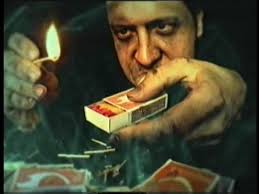 $62.5 million is going to setting fire to Blue Mountains World Heritage
How much or little goes to protecting endangered wildlife and their Recovery Plans?
Zilch across the Blue Mountains? $62.5 million is going to setting fire to Blue Mountains World Heritage
How much or little goes to protecting endangered wildlife and their Recovery Plans?
Zilch across the Blue Mountains?
.
Perhaps this National Parks Report from 2007 in the Blue Mountains, which is probably sitting on some dusty NPWS shelf, may ring a bell for our Mr Luscombe.
Do the recognised practices of “mosaic burning” and “retaining fauna habitats in a long unburnt state” have any meaning in National Parks management?
.
.
Tags: Blue Mountains, Fauna of the Blue Mountains Special Areas, Geoff Luscombe, Greater Blue Mountains World Heritage Area, hazard cult orthodoxy, hazard reduction, Hazard Reduction Programme, Helicopter Aerial Incendiary, NPWS, playing with matches, tigerquoll, Wild Dog Mountains
Posted in Blue Mountains (AU), Threats from Bushfire | No Comments »
Add this post to Del.icio.us - Digg
Friday, May 10th, 2013
 Sad Sight: Blue Mountains resident Aanya Mary
devastated by the senseless slaughter of Bullaburra’s Angophora
Blue Mountains, New South Wales, Australia
.
But to road engineers with Sydney’s RTA-come-RMS:
“..it was just the easy and efficient option”
..in order that more B-Doubles get line-of-sight through Bullaburra as they nudge 90kph to keep their job
[Source: ‘Centuries-old tree makes way for highway upgrade’, 20130410, by Shane Desiatnik, Blue Mountains Gazette, p.13,
^http://www.bluemountainsgazette.com.au/story/1419083/bullaburra-tree-makes-way-for-highway-widening/]
Sad Sight: Blue Mountains resident Aanya Mary
devastated by the senseless slaughter of Bullaburra’s Angophora
Blue Mountains, New South Wales, Australia
.
But to road engineers with Sydney’s RTA-come-RMS:
“..it was just the easy and efficient option”
..in order that more B-Doubles get line-of-sight through Bullaburra as they nudge 90kph to keep their job
[Source: ‘Centuries-old tree makes way for highway upgrade’, 20130410, by Shane Desiatnik, Blue Mountains Gazette, p.13,
^http://www.bluemountainsgazette.com.au/story/1419083/bullaburra-tree-makes-way-for-highway-widening/]
 ‘You don’t know what you’ve got
till it’s gone’ ‘You don’t know what you’ve got
till it’s gone’
.
Two generations after the 1960s grassroots protests against corporate environmental destruction and corrupted government bullying justification of ‘progress’, nothing has changed.
.
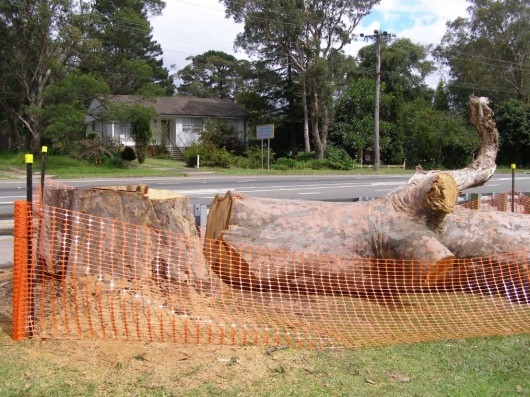 Public display of Government slaughter of local heritage
“Let this be a lesson that Sydney rules over you.”
(But Bullaburra is not 1940’s Poland; we are not Sydney)
[Photo by Editor, 20130406, Photo © ^Creative Commons] Public display of Government slaughter of local heritage
“Let this be a lesson that Sydney rules over you.”
(But Bullaburra is not 1940’s Poland; we are not Sydney)
[Photo by Editor, 20130406, Photo © ^Creative Commons]
.
They Took All the Trees
.
They took all the trees, put ‘em in a tree museum” (Joni Mitchell, 1970), yet forty years hence we’re still killing 300 year old native trees for a ‘paved paradise.’
Back in September 2008, a communiqué released by the RTA-come-RMS confirmed that this heritage listed red gum (photo) alongside the highway at Bullaburra was to be killed to widen the highway. It didn’t give a reason to the community, but in its Review of Environmental Effectsjustified the tree’s demise by requiring line of sight for more trucks so they can hurtle through Bullaburra at a new increased speed of 80kph, but nudging 90.
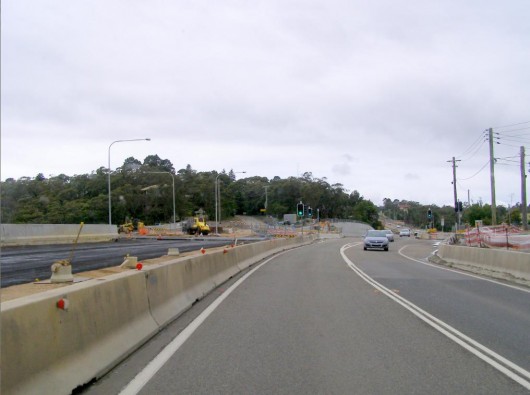 Great Western Highway paved paradise
[Photo by Editor, 20110115, Photo © ^Creative Commons] Great Western Highway paved paradise
[Photo by Editor, 20110115, Photo © ^Creative Commons]
.
The implication was to not just widen the existing highway and make it safer, but to carve a trucking expressway through as though no Bullaburra community existed; just like they did to neighbouring Lawson and Wentworth Falls, and the other now divided highway towns and villages along the Great Western Highway. And the lessons from the even wider and faster M4 motorway down the hill is that the outcomes have not made the journey safer. Statistically, faster and bugger trucks have made the M4 motorway and the already widened sections of the Great Western Highway, even more dangerous.
Killing Bullaburra’s Tree was wrong like an invading army shooting surrendering locals because it is inconvenient to imprison them. To the RTA-come-RMS, decimating local amenity is but collateral damage. Any wonder propaganda pamphlets were not dropped over the village in the weeks leading up to the carnage like the US did in the Vietnam War.
Widening the highway is the wrong encouragement for an efficient NSW freight system and won’t address road safety. The widening is destroying local heritage and community values. It is politically short-sighted on all counts.
.
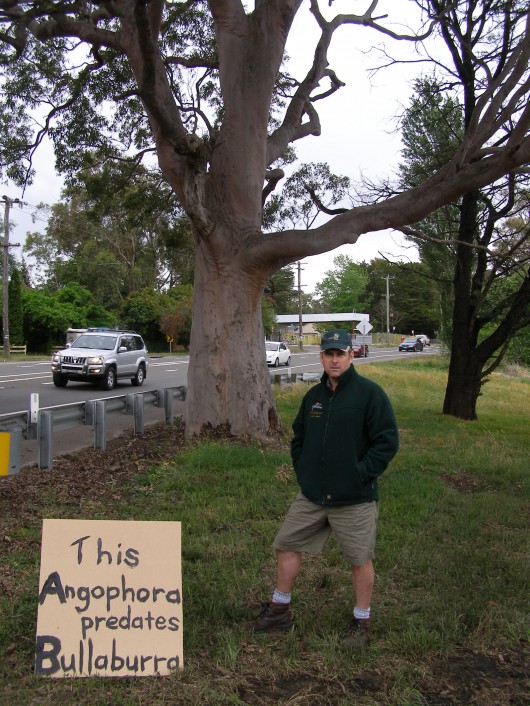 Protest 6 years ago in October 2007 to save this healthy heritage tree
A tree that predated colonial Australia of 1788
An expendable victim of an ambivalent Blue Mountains Council’s
‘Significant Tree Register’ of community deceit.
[Photo by Editor, 20071028, Photo © ^Creative Commons] Protest 6 years ago in October 2007 to save this healthy heritage tree
A tree that predated colonial Australia of 1788
An expendable victim of an ambivalent Blue Mountains Council’s
‘Significant Tree Register’ of community deceit.
[Photo by Editor, 20071028, Photo © ^Creative Commons]
.
Blue Mountains Significant Tree Register – deceitful faux conservation
.
Bullaburra’s Angophora was a rare symbolic remnant of the dominant Angophora Forest habitat that once flourished in the Bullaburra area and which has earned listing on council’s Register of Significant Trees.
Consultation with a local (Level 5) arborist with expertise in Angophoras, had confirmed the tree an Angophora costata and “between 200 and 300 years old and that if given the chance will survive between 400 and 600 years.” So it predated Bullaburra (1924) and predated the colonisation of Australia (1788).
Why did local Blue Mountains Council turn its back on its own heritage register and on Mountains heritage. Had traditional owners been consulted?
Blue Mountains Council’s Significant Trees were in 1988 registered under Development Control Plan 9 (DCP9): the purpose of which was to identify and protect those trees listed on the Register; promote greater public awareness of the existence of the Register, and the individual items listed; ensure existing and, importantly, prospective land owners, are made aware of the Significant Trees which may be located on their property; and ensure correct on-going care and maintenance of those trees listed, through the recommendations included with the significant tree register.
DCP 9 was formally adopted in 21 June 1988 and since then had effected no legal weight or meaning. The tens of thousands spent on the plan then and since has been a financial misappropriation.
.
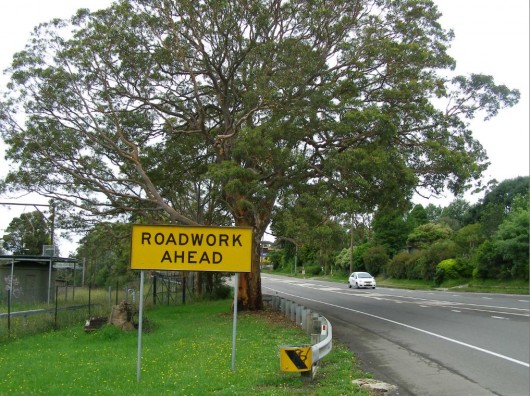 Bullaburra’s Angophora
circa 1700 – 1st April 2013
A familar Blue Mountains icon that withstood ^Robber Baron Progress for 300+ years
Council ratified to the people in writing that it was a protected ‘Significant Tree‘
Until Bob Debus and the RTA-come-RMS expressway arrogance imposed its Sydney industrialist will.
[Photo by Editor, 20130406, Photo © ^Creative Commons] Bullaburra’s Angophora
circa 1700 – 1st April 2013
A familar Blue Mountains icon that withstood ^Robber Baron Progress for 300+ years
Council ratified to the people in writing that it was a protected ‘Significant Tree‘
Until Bob Debus and the RTA-come-RMS expressway arrogance imposed its Sydney industrialist will.
[Photo by Editor, 20130406, Photo © ^Creative Commons]
.
The then Federal Member for Macquarie (Blue Mountains), Bob Debus MP, openly supported and encouraged the RTA-come-RMS in its highway widening through Blue Mountains communities.
Debus had publicly praised the RTA for “doing exemplary work in consultation with…local communities.” (Blue Mountains Gazette 20081126).
Yet this Editor, who for the past seven years has observed and participated in numerous RTA-come-RMS community consultation workshops dealing with the Trucking Expressway mission along the Great Western Highway, has found all ‘community consultation’ to be but a recurring deceitful farce designed purely for public relations and so that on paper, community consultation was legally ‘seen to be done’.
The Juggernaut Cake was baked, and the community herded and selected to choose the colour of the icing. So thanks for coming dumb peasants!
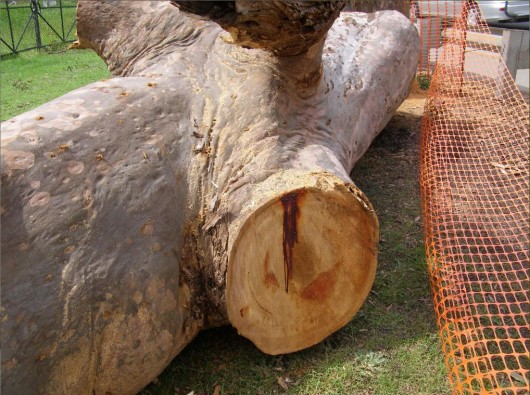 Photo by Editor, 20130406, Photo © ^Creative Commons Photo by Editor, 20130406, Photo © ^Creative Commons
.
The sad thing is that we see each community hoodwinked one by one, losing rights and amenity to an expanding Sydney conurbation of our Mountains. How many minutes will widening cut through the Mountains only to be added back in Sydney congestion and the chronic truck queues at Port Botany? If widening claims to address highway safety why does the six-lane M4 have the highest accident rate in the State?
Debus has publicly been the key driver of the highway widening and increased traffic policy prepared to splurge half a billion dollars to encourage more trucks on our roads and committing a teetering NSW Government already heading into deficit. Debus’ myopic fixation with trucks has cast him as a reckless pariah against the Federal government’s promise of meeting Kyoto emission targets. He and his babyboomer age group seem locked in a truck-centric mindset, one that is anti-rail like Premier Nick Greiner’s condemning of freight rail (1988-92) and like US President Eisenhower’s industrial superhighway ruination of Northern America back in the 1950s.
[Source: ‘They took all the trees’, 20081203, letter in the Blue Mountains Gazette local newspaper, in print]
.
They took all the trees, put ‘em in a tree museum..
by Canadian singer, composer and lyricist Joni Mitchell from her classic hit ‘Big Yellow Taxi’ from her album ‘Ladies of the Canyon’ released in April 1970.
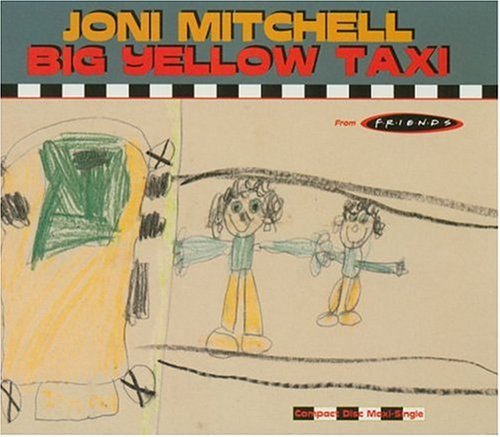 Joni Mitchell’s single cover Joni Mitchell’s single cover
Her original recording was this single, but then released later on her album ‘Ladies of the Canyon’ (1970)
Yet forty three years hence dear lady and what have we learnt from your sad message about the bulldozing of Nature?
.
“Big Yellow Taxi” became a hit in Joni’s native Canada (#14) as well as Australia (#6) and the UK (#11).
Joni: “I wrote ‘Big Yellow Taxi’ on my first trip to Hawaii. I took a taxi to the hotel and when I woke up the next morning, I threw back the curtains and saw these beautiful green mountains in the distance. Then, I looked down and there was a parking lot as far as the eye could see, and it broke my heart… this blight on paradise. That’s when I sat down and wrote the song.”
The song is known for its environmental concern – “They paved paradise to put up a parking lot” and “Hey farmer, farmer, put away that DDT now”.
 Joni Mitchell in 1970 Joni Mitchell in 1970
.
The song line “They took all the trees, and put ’em in a tree museum…and charged the people a dollar and a half just to see ’em” refers to Foster Botanical Garden in downtown Honolulu, which is a living museum of tropical plants, some rare and endangered.
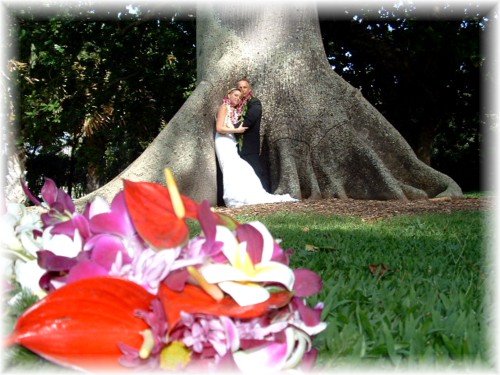 A wedding in Foster Botanical Garden, Hawaii
A wedding in Foster Botanical Garden, Hawaii
[Source: ^http://www.alohaislandweddings.com/foster_botanical_gardens.htm]
.
These days, Honolulu’s Foster Botanical Garden has become home to hundreds of species of endangered Hawaiian and other exotic plants. The garden’s mission is to plan, develop, curate, maintain and study documented collections of tropical plants in an aesthetic setting for the purposes of conservation, botany, horticulture, education, and recreation. While it is very important to teach people about the natural flora of Hawaii, it is a shame that they have to be kept in such a tree museum and are not able to be appreciated in their natural settings.
.
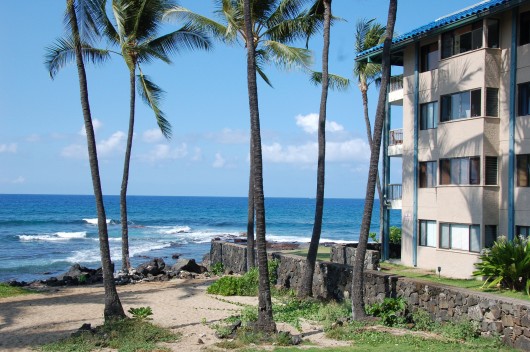 Colonising destruction of Natural Hawaii Colonising destruction of Natural Hawaii
.
Bullaburra’s Angophora was that roadside tree, always there, estimated to be between up to 200 and 300 years old, but took only a few hours to chop down to a stump on April Fools Day to clear the way for highway widening work in Bullaburra.
The decision to remove the tree listed on council’s Significant Tree Register was made back in 2009. This is the coniving strategy of the RTA-come RMS employeing those with degrees in ‘Media Communications’ – this 21C black art of corporate propaganda. Move over 20th C Used Car Salesmen, Y-Gens in Media Communications are the new low-life to be avoided.
But the shock of seeing the 30-metre tall smooth-barked apple red gum being removed was too much for some local residents, who gathered beside it to take photos and quietly reflect.
Katoomba resident Aanya Mary said she was devastated by the loss of the tree and the public not being told when it was going to be removed. She called the decision to chop it “the easy and efficient option” and questioned if other solutions were thoroughly considered.
“This tree would have seen generations of Gundungurra and Darug people rest under its boughs and no doubt [the explorers] Lawson, Blaxland and Wentworth passed its gracious trunk.”
In a callous afterthought, the RTA-come-RMS has offered to use wood of the tree to create ukuleles and furniture. Can Chopin’s funeral march be played on a Ukele?
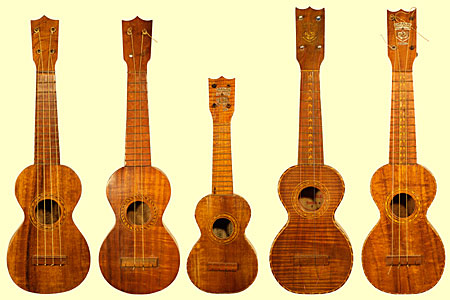 Some callous bureaucrat in the RTA-come-RMS suggested using the Angophora wood to make stupid Ukeles
Not even into traditional Aboriginal instruments, weapons or tools.
The minds at RMS Paramatta head office are urbane and bewildered. Some callous bureaucrat in the RTA-come-RMS suggested using the Angophora wood to make stupid Ukeles
Not even into traditional Aboriginal instruments, weapons or tools.
The minds at RMS Paramatta head office are urbane and bewildered.
.
Yet others, more attached to the tree and aware of the behind the scenes political deceit, have suggested making council coffins for those who signed off on the Angophora’s demise.
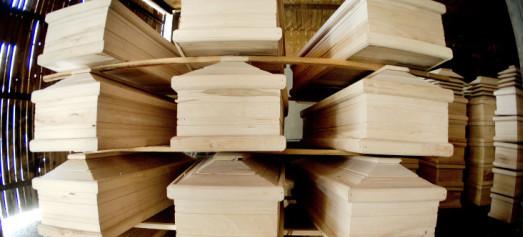 . .
[Source: ‘Bullaburra tree makes way for highway widening’, 20130410, by Shane Desiatnik, journalist, Blue Mountains Gazette newspaper, p.13, ^http://www.bluemountainsgazette.com.au/story/1419083/bullaburra-tree-makes-way-for-highway-widening/]
.
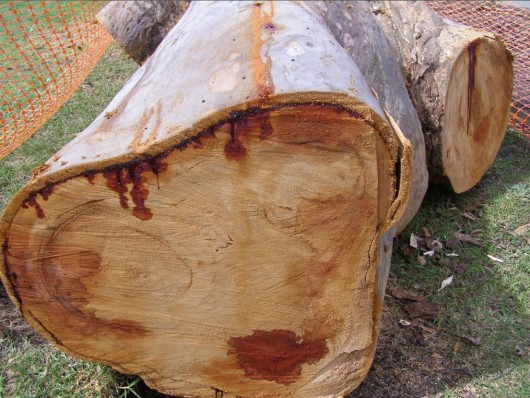 [Photo by Editor, 20130406, Photo © ^Creative Commons] [Photo by Editor, 20130406, Photo © ^Creative Commons]
.
Blue Mountains failure to preserve Natural History
.
<<The sudden and surreptitious removal of the mature heritage-listed Eucalypt at Bullaburra last week was avoidable and a total failure of our ability to preserve our natural history.
That tree was the property of the Blue Mountains community just as much as the community hall at Bullaburra.
When it can be arranged for the highway widening to bypass the community hall, there is no reason it couldn’t be diverted around another significant and far older landmark.
Not only did Blaxland, Lawson and Wentworth pass close by this tree in 1813 but the following year the first road was built almost under its branches. The year after, 1815, Lachlan Macquarie and his entourage passed by this tree as the first public users of the road through the Blue Mountains. In the 1830s Charles Darwin also made the journey passed it.
Blue Mountains (..) Council has failed miserably to protect our natural history. It’s also obvious how totally toothless is the rhetoric around the Significant Tree Register.
The RTA-come-RMS suggestion to make use of the wood is an attempt to sidetrack and trivialises its destruction. Who needs a symbol of the endurance of natural beauty when you can have ukeleles and matches?
Trees like this are the Blue Mountains community’s natural history – not the RTA-come-RMS’s.
The bottom line is there is no legislation to protect our natural history, and any clowns with clout can get their way.
Why doesn’t the Blue Mountains (..) Council stand up for us and for the naturakl environment in matters like these?>>
.
[Source: ‘Heritage tree’ (discretionary label by BMG editor), 20130417, by P.D. Bonney, of Faulconbridge, letter to the editor, in Blue Mountains Gazette (local newspaper), page 4, print only]
.
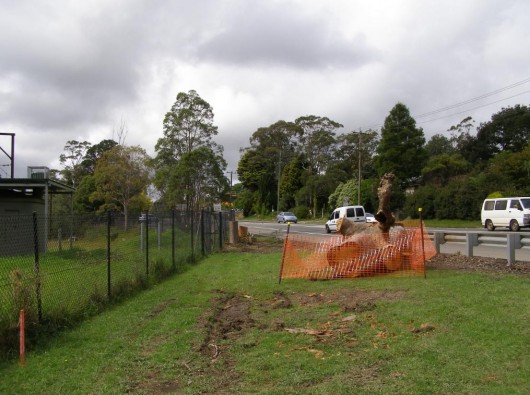 To passers-by this is just another log, like heritage ignored
and so unknowingly foresaken and lost forever.
[Photo by Editor, 20130406, Photo © ^Creative Commons] To passers-by this is just another log, like heritage ignored
and so unknowingly foresaken and lost forever.
[Photo by Editor, 20130406, Photo © ^Creative Commons]
.
Ed: But when Government comes intimidating the homes and amenity of these passers-by? So loud the NYMBY’s plead for community support.
To reliable taxpayer-funded bureaucrats inside RTA-come-RMS, community NYMBYISM has become a strategic community vunerabilty so exploited to known consultant formalae. But so unprepared are communities like the Blue Mountains for exploitation that they are prone to and succumb to industrial rape, village by village, and cleverly silenced by the consultants.
But once the Government’s omnipotent Juggenaut invasion arrives and the overwhelming household helplessness, locals try selling up in vain and a few commit quiet, unreported suicide. It is ultimately then, that Government has come, seen and conquered its own taxpayers so that such issues shrink from mainstream media, are excluded from government statistics and so are relegated into invisiblity, the history cleansed and revised by the government consultants.
Tags: Blue Mountains, Blue Mountains Council, Bullaburra Angophora, Great Western Highway, Joni Mitchell, local heritage, preserve natural history, RTA-come-RMS, Significant Tree Register, they took all the trees, ukuleles
Posted in Blue Mountains (AU), Threats from Road Making | No Comments »
Add this post to Del.icio.us - Digg
Saturday, April 6th, 2013
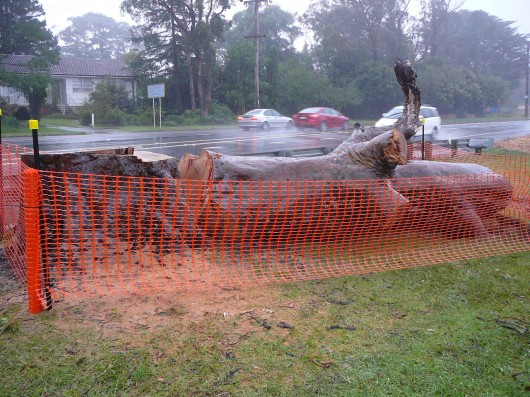 The trunk of a healthy 300+ year old Angophora lies beside the highway in Bullaburra
Blue Mountains, New South Wales, Australia
[Photo by our investigator, 20130403, Photo © ^Creative Commons] The trunk of a healthy 300+ year old Angophora lies beside the highway in Bullaburra
Blue Mountains, New South Wales, Australia
[Photo by our investigator, 20130403, Photo © ^Creative Commons]
.
Government destruction of Bullaburra has begun. Last Monday, April Fools Day 2013, they came and killed Bullaburra’s magificent Angophora to make way for a trucking expressway through the village. But who are the fools who destroy our native heritage?
To many perhaps this is just another tree. Some people value trees and ecology. Others have deep value for wildlife and other animals, especially their pets. Many people value where they live and grow very attached to where they live for reasons that can seem difficult for others to appreciate. But it is the existence rights of species that humans ignore besides their own self-serving interests. Male Baby Boomers remain the most extreme in their self-righteousness, and those in government prescribe utilitarian dictates over the rights of the few.
Elie Wiesel, novelist, political activist, and Humanities Professor at Boston University, has said that the opposite of love is not hate, it’s indifference. The opposite of beauty is not ugliness, it’s indifference. The opposite of faith is not heresy, it’s indifference. And the opposite of life is not death, but indifference between life and death.
.
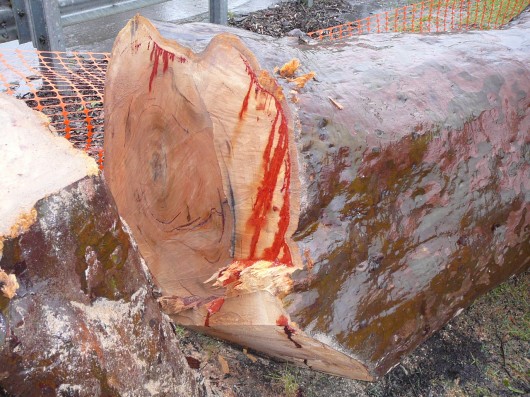 Witnessing an old friend being slaughtered
[Photo by our investigator, 20130403, Photo © ^Creative Commons] Witnessing an old friend being slaughtered
[Photo by our investigator, 20130403, Photo © ^Creative Commons]
.
A native tree that once was part of an Angophora (Sydney Redgum) forest, existed way back when the three explorers Lawson, Wenthworth and Blaxland crossed the Blue Mountains in 1813. They would have passed right past this tree. Two years later road builder William Cox similarly would have laid his rough track, and in 1836 Major Mitchell upgrading the road too would have passed by this tree. For nearly two centuries travellers have passed by this tree, most probably not even giving it a glance. Now it is gone and the opportunity to respect and appreciate this remnant of natural heritage has gone with it.
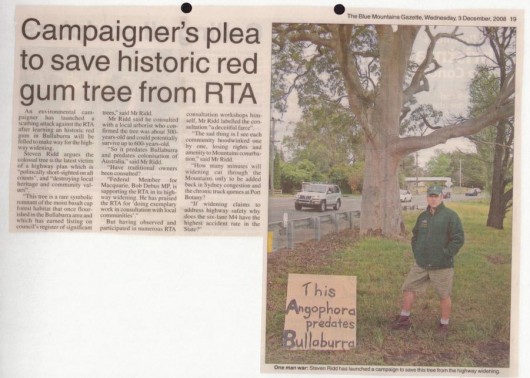 We tried to save you
Campaign to Save Bullaburra’s 300 year old Angophora back in 2008
(Blue Mountains Gazette, 20081203) We tried to save you
Campaign to Save Bullaburra’s 300 year old Angophora back in 2008
(Blue Mountains Gazette, 20081203)
.
Last January, spiteful people set fire to two Hermmansburg ghost gums made famous in Albert Namatjira’s landscape paintings. In 2006, Barcaldine’s famous ghost gum, ‘the tree of knowledge’ was poisoned. Just last week an old gum tree in the Rylstone public school was poisoned. Human hate for native trees has pervaded Australian colonising society since Cook landed at Camp Cove and chopped down trees for firewood.
.
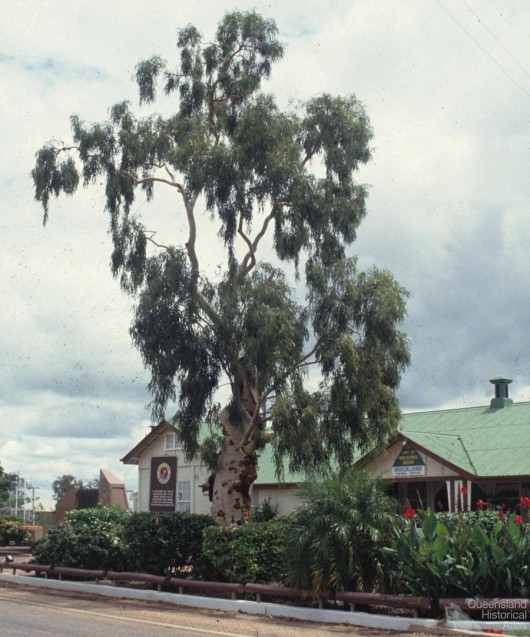 Tree of Knowledge, Barcaldine, Queensland
As it used to be, before it was poisioned.
[Source: Queensland Historical Atlas, 1991,
^http://www.qhatlas.com.au/photograph/tree-knowledge-barcaldine-1991] Tree of Knowledge, Barcaldine, Queensland
As it used to be, before it was poisioned.
[Source: Queensland Historical Atlas, 1991,
^http://www.qhatlas.com.au/photograph/tree-knowledge-barcaldine-1991]
.
A local arborist with expertise in native trees of the Blue Mountains including Angophoras, estimated in 2007 that the Bullaburra Angophora to have been over 300 years old. It was still healthy and still growing as confirmed by the solid core of the severed trunk.
Now it lies like a dead harpooned whale like roadkill beside the highway, where it has stood all those decades.
.
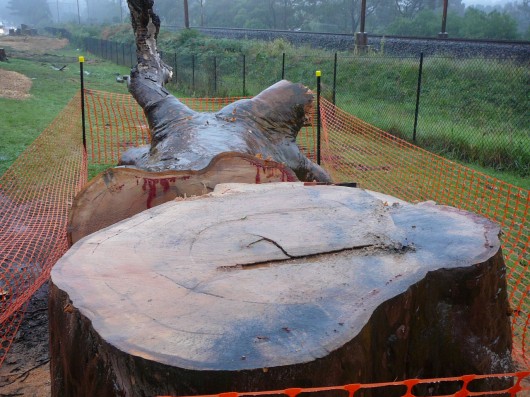 A dendrochronology of more than 300 annual growth rings.
The tree was healthy to the core. It was not rotting. It was not diseased.
It was just in the way of someone’s trucking interpretation of ‘progress’.
[Photo by our investigator, 20130403, Photo © ^Creative Commons] A dendrochronology of more than 300 annual growth rings.
The tree was healthy to the core. It was not rotting. It was not diseased.
It was just in the way of someone’s trucking interpretation of ‘progress’.
[Photo by our investigator, 20130403, Photo © ^Creative Commons]
.
Significant Tree #29
.
This Angophora was recognised as a ‘Significant Tree‘ on the local Blue Mountains Council’s Significant Tree Register back on 17th July 1985 and formally adopted on 21st June 1988, at the time of Australia’s Bicentennary.
No opposition against killing the tree was communicated by the Blue Mountains Council to the RTA-come-RMS. Indeed, this is one of many such ‘significant trees’ that have been killed for development convenience in recent years. Clearly, the Blue Mountains Council’s Significant Tree Register has become disingenuous and lying greenwash.
.
.
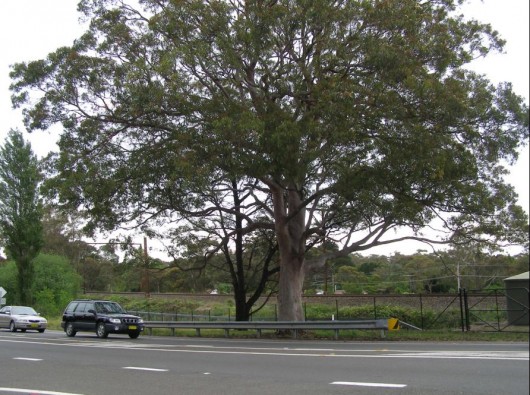 Bullaburra’s Angophora, in memoriam Bullaburra’s Angophora, in memoriam
Registered Significant Tree #: 29
Botanical Name: Angophora costata (Smooth Barked Apple, Red Gum)
Location: Great Western Highway Bullaburra, Opp. Lot 173, DP13407
[Photo by Editor, 20071028, Photo © ^Creative Commons]
.
Trucking Expressway
.
The death of the Angophora is the begining of the end of Bullaburra. The highway village is set to become a siding for four-laned trucking expressway so that B-double trucks can rumble 24/7 through Blue Mountains towns and villages, nudging 90kph on cruise control.
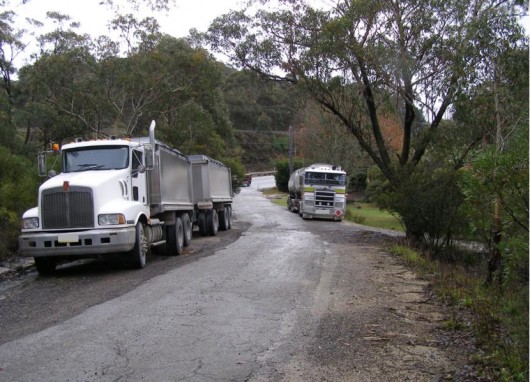 Bigger Trucks demanding bigger roads
[Photo by Editor, 20090531, Photo © ^Creative Commons] Bigger Trucks demanding bigger roads
[Photo by Editor, 20090531, Photo © ^Creative Commons]
.
The rural amenity of this highway village is to be lobotomised into a mono-design urban landscape taking on the same monotonous blandness as any other expressway in the country. The government euphemises this as:
.
“to achieve greater consistency in the design of the Blue Mountains area to achieve a simple and unified design of the highway and its elements.”
.
The fundamental basis for the government’s conversion of this regional highway into a national trucking expressway route is simply “to improve travel times” for trucks, so that more and larger trucks are encouraged to use the route.
The Bullaburrra section is to cost taxpayers $80 million and will see 3.6 hectares of native bushland destroyed on the basis that the vegetation “is already dissected and fragmented“. So it seems that moral relativism allows for wedge development just like a little bit of corruption doesn’t hurt anyone.
But as if the twisted morality isn’t bad enough. It is the greenwashing that really twists the knife in. The RTA-come-RMS in its Review of Environmental Effects maintains that the expressway development aims:
“to protect the natural systems and ecology of the corridor”
..
[Source: ‘The Great Western Highway Upgrade – Bullaburra East, Review of Environmental Effects’, Vol.2, July 2009, Roads and Traffic Authority, New South Wales Government, p.2.]
.
However, the expressway development will simply result in the heart of rural Bullaburra being ripped out and the amenity reduced to a trucking siding adopting a benale concrete landscape akin to the bland urban character of an upper Blaxland, and mirroring what has happened to nearby lobotomised Lawson.
.
“It’s just really tragic after all the horrors of the last 1,000 years we can’t leave behind something as primitive as government sponsored execution.”
~ Wisconsin Senator Russ Feingold, when introducing a bill that would end the death penalty on the Federal level.
.
Progress of Hate
.
Under Australia’s Federal Auslink Policy the national freight thinking is road-centric and all about replacing real trains with road trains. Behind this trucking expressway scheme is a powerful and influential trucking lobby group who donate generously to the political parties that control the New South Wales Government, and various politicians including retired Blue Mountains MP Bob Debus, who has long been a driver of this trucking expressway.
The New South Wales Government department behind this scheme is the RTA-come-RMS (Roads and Maritime Services). In 2007, the then General Manager – Environmental Branch, Ms Erica Adamson, claimed that to retain the Angophora consequential loss of tree roots and pruning would instigate the decline of the tree. “For road construction and safety reasons the tree will have to be removed…to maintain sight lines (for speeding trucks).”
“It’s called progress” they say. For the Blue Mountains it is being inflicted at any cost – economic, social, environmental.
The idea of ‘progress‘ is an economic one that was borne out of Western 18th Century hard-nosed Industrial Revolution and perhaps extending back to the 16th Century Enlightenment of Europe and perhaps even back to when the Iron Age triumphed so aggressively and effectively over the Bronze Age.
Perhaps progress remains subjective only with the progressor who doggedly in his pursuit rough shods over others in the process. Perhaps the idea of progress is a myth. Is the human condition better off as a result? Are we advancing as a society by rough shodding over others and over what is left of Ecology and Nature? The philosophy of ‘^Deep Ecology‘ posits otherwise.
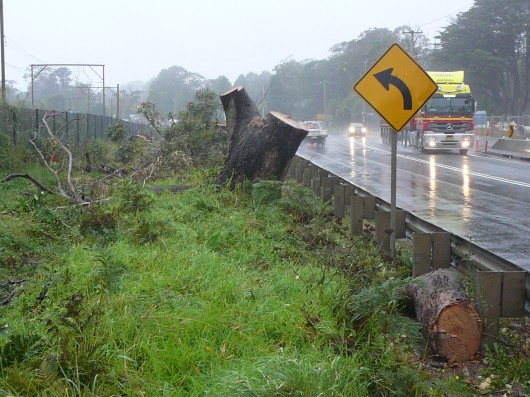 Progress of Hate
[Photo by our investigator, 20130403, Photo © ^Creative Commons] Progress of Hate
[Photo by our investigator, 20130403, Photo © ^Creative Commons]
.
“Progress means getting nearer to the place you want to be. And if you have taken a wrong turning, then to go forward does not get you any nearer. If you are on the wrong road, progress means doing an about-turn and walking back to the right road; and in that case the man who turns back soonest is the most progressive man.”
~ C.S. Lewis, Mere Christianity
.
Related reading on this website:
.
[1] >Threats from Road Making – articles
.
[2] >Bushphobia – a case of deluded convenience
.
Tags: Blue Mountains, Blue Mountains Council, BMCC, Bullaburra, Bullaburra Angophora, Bullaburra's Angophora, ghost gums, Great Western Highway, greenwash, RMS, Roads and Maritime Services, RTA, RTA-come-RMS, Significant Tree, Significant Tree Register, Tree of Knowledge, trucking expressway
Posted in Blue Mountains (AU), Threats from Greenwashing, Threats from Road Making | 1 Comment »
Add this post to Del.icio.us - Digg
|
|
 Frosty Morning in the Gully
[Photo by Editor, 20130711, Photo © under ^Creative Commons]
Click image to enlarge
Frosty Morning in the Gully
[Photo by Editor, 20130711, Photo © under ^Creative Commons]
Click image to enlarge



















 An example of a purpose-built Wombat Gate
If one can afford property at exclusive Mount Wilson with average prices currently $750,000 [^
An example of a purpose-built Wombat Gate
If one can afford property at exclusive Mount Wilson with average prices currently $750,000 [^



























































































